Paul van Yperen's Blog, page 394
January 15, 2015
Peter Pasetti
Peter Pasetti (1916–1996) was a German stage, television and film actor. The handsome and incisive character actor played a number of leading roles in post-Second World War productions such as the operetta film Eine Nacht in Venedig/A Night in Venice (1953). From the late 1950s he appeared increasingly on television.
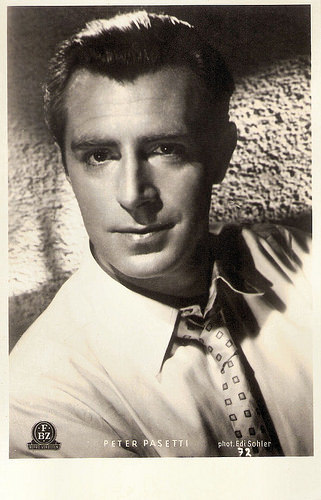
German postcard by F.B.Z., no. 72. Photo: Edi Sohler.
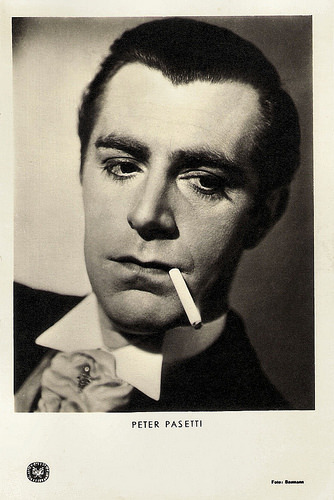
German postcard by Kitt Photokarten, München (Munich), no. 526. Photo: Baumann.
Degenerate Art
Peter Viktor Rolf Pasetti was born in Munich in the German Empire in 1916. His father Leo Pasetti was an architect and stage designer for the Bayerischen Staatsoper.
He studied music and acting, and made his stage debut at the Bayerischen Landesbühne. In 1940 he made his film debut in the historical comedy Das Fräulein von Barnhelm/The Girl from Barnhelm (Hans Schweikart, 1940) starring Käthe Gold . It is an adaptation of the classic play Minna von Barnhelm (1767) by Gotthold Ephraim Lessing.
He also had a small part in the drama Venus vor Gericht/Venus on Trial (Hans H. Zerlett, 1941), starring Hannes Stelzer , Hansi Knoteck and Paul Dahlke. The film was part of the Nazi's campaign against 'degenerate art', and depicts the trial of a young artist who has resisted the trend towards it.
Then World War II caused a break in his film career. After the war, Peter Pasetti belonged to the Münchner Kammerspiele, from 1947 till 1979.
In 1948 he returned to the screen in the comedy Die kupferne Hochzeit/The Copper Wedding (Heinz Rühmann, 1948) with Hertha Feiler . His next films were Der Herr vom andern Stern/The Lord from another planet (Heinz Hilpert, 1948) starring Heinz Rühmann , and Du bist nicht allein/You are not alone (Paul Verhoeven, 1949).
In the musical Sensation in San Remo (Georg Jacoby, 1951), Peter Pasetti co-starred with Marika Rökk . The film, partly set at the Sanremo Festival in Italy, was one of Rökk's most successful post-war films. Mart Sander at IMDb : “Very superfluous and light entertainment, where you can predict every word, gesture and action from the beginning to the happy end.”
In the adventure film Jonny rettet Nebrador/Jonny Saves Nebrador (Rudolf Jugert, 1953), he appeared opposite Hans Albers and Margot Hielscher . The film is set in South America, but was shot on location in Italy.
In 1957 he appeared as Dr. Busch in the DEFA-production Spielbank-Affäre/Casino affair (Arthur Pohl, 1957), next to Gertrud Kückelmann and Jan Hendriks .
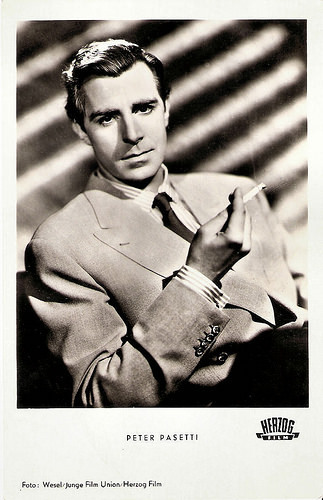
German postcard by Kunst und Bild, Berlin, no. A 373. Photo: Wesel / Junge Film-Union / Herzog Film. Publicity still for Sensation in San Remo (Georg Jacoby, 1951).
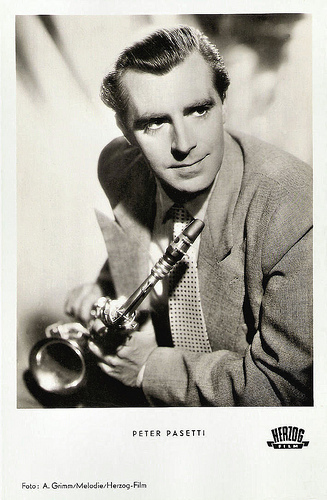
German postcard by Kunst und Bild, Berlin, no. A 648. Photo: Arthur Grimm / Melodie / Herzog-Film. Publcity still for Heimweh nach dir/Hitparade (Robert A. Stemmle, 1952).
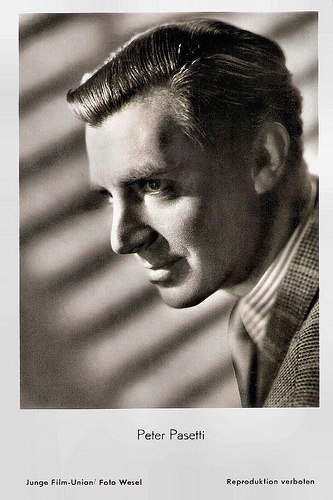
German postcard by Filmpostkartenverlag, Hamburg-Bergedorf, no. 176. Photo: Junge Film-Union / Wesel.
The German voice of Alfred Hitchcock
During the 1960s, 1970s and 1980s, Peter Pasetti focused more on stage and on TV. He played in countless TV series, including the popular mini-series Am grünen Strand der Spree (Fritz Umgelter, 1960). At IMDb , Ernst Wiltmann writes: “a haunting timetravel to a lost German way of live.“
Pasetti also appeared in Krimi series like Der Kommissar/The Commissionar (1971-1974), Tatort (1977), Der Alte/The Old Fox (1977-1991), and Derrick (1975-1992). He was the German voice of Skeletor in the Masters of the Universe radio play (1984-1987) and also the German voice of Alfred Hitchcock in the The Three Investigators radio play (1979-1995).
Pasetti also worked as a voice actor and dubbed Humphrey Bogart in We’re no Angels (Michael Curtiz, 1955), Gary Cooper in High Noon (Fred Zinnemann, 1952), Orson Welles in The Lady from Shanghai (Orson Welles, 1947), and Joseph Cotten in Citizen Kane (Orson Welles, 1941).
One of his later films is the drama Die Zeit der Schuldlosen/Time of the Innocent (Thomas Fantl, 1964), starring Erik Schumann. The film premiered at the 14th Berlin International Film Festival in the presence of President Lübcke and his wife, and many other German politicians.
He also could be seen in the film Und Jimmy ging zum Regenbogen/And Jimmy went to the Rainbow (Alfred Vohrer, 1971), which was based on the novel The Caesar Code by Johannes Mario Simmel. It was filmed in Vienna and Munich.
Pasetti also played Professor Gaspardi in the melodrama Das Chinesische Wunder/The Chinese Miracle (Wolfgang Liebeneiner, 1977). Jan Onderwater at IMDb : “Not only the subject of the badly written script is boring, Liebeneiner directs with disinterest - and who could blame him. The cast seems to be on heavy drugs, with the exception of Heinz Rühmann who has a fine performance during 30 minutes or so but cannot save the film; and what is his character doing in Hong Kong anyway?”
Pasetti’s final feature film was Smaragd/Emerald (Veith von Fürstenberg, 1987).
Peter Pasetti died in 1996 in Dießen am Ammersee, Germany.
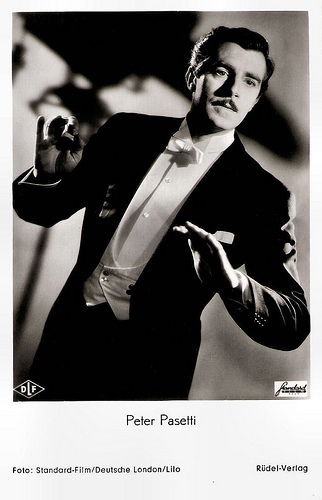
German postcard by F.J. Rüdel, Filmpostkartenverlag, Hamburg-Bergedorf, no. 1236. Photo: Standard-Film / Deutsche London / Lilo.
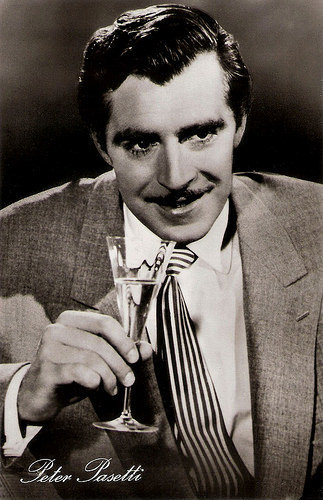
East-German postcard by VEB Progress Filmvertrieb, Berlin, no. 442, 1957. Photo: Standard-Film. Publcity still for Drei vom Varieté/Three of vaudeville (Kurt Neumann, 1954).
Peter Pasetti performs Komm in die Gondel, mein Liebchen, o steige nur ein in the operetta film Eine Nacht in Venedig/A Night in Venice (Georg Wildhagen, 1953). Source: Fritz51267 (YouTube).
Sources: Stephanie D’heil (Steffi-line - German), Wikipedia (German and English) and .

German postcard by F.B.Z., no. 72. Photo: Edi Sohler.

German postcard by Kitt Photokarten, München (Munich), no. 526. Photo: Baumann.
Degenerate Art
Peter Viktor Rolf Pasetti was born in Munich in the German Empire in 1916. His father Leo Pasetti was an architect and stage designer for the Bayerischen Staatsoper.
He studied music and acting, and made his stage debut at the Bayerischen Landesbühne. In 1940 he made his film debut in the historical comedy Das Fräulein von Barnhelm/The Girl from Barnhelm (Hans Schweikart, 1940) starring Käthe Gold . It is an adaptation of the classic play Minna von Barnhelm (1767) by Gotthold Ephraim Lessing.
He also had a small part in the drama Venus vor Gericht/Venus on Trial (Hans H. Zerlett, 1941), starring Hannes Stelzer , Hansi Knoteck and Paul Dahlke. The film was part of the Nazi's campaign against 'degenerate art', and depicts the trial of a young artist who has resisted the trend towards it.
Then World War II caused a break in his film career. After the war, Peter Pasetti belonged to the Münchner Kammerspiele, from 1947 till 1979.
In 1948 he returned to the screen in the comedy Die kupferne Hochzeit/The Copper Wedding (Heinz Rühmann, 1948) with Hertha Feiler . His next films were Der Herr vom andern Stern/The Lord from another planet (Heinz Hilpert, 1948) starring Heinz Rühmann , and Du bist nicht allein/You are not alone (Paul Verhoeven, 1949).
In the musical Sensation in San Remo (Georg Jacoby, 1951), Peter Pasetti co-starred with Marika Rökk . The film, partly set at the Sanremo Festival in Italy, was one of Rökk's most successful post-war films. Mart Sander at IMDb : “Very superfluous and light entertainment, where you can predict every word, gesture and action from the beginning to the happy end.”
In the adventure film Jonny rettet Nebrador/Jonny Saves Nebrador (Rudolf Jugert, 1953), he appeared opposite Hans Albers and Margot Hielscher . The film is set in South America, but was shot on location in Italy.
In 1957 he appeared as Dr. Busch in the DEFA-production Spielbank-Affäre/Casino affair (Arthur Pohl, 1957), next to Gertrud Kückelmann and Jan Hendriks .

German postcard by Kunst und Bild, Berlin, no. A 373. Photo: Wesel / Junge Film-Union / Herzog Film. Publicity still for Sensation in San Remo (Georg Jacoby, 1951).

German postcard by Kunst und Bild, Berlin, no. A 648. Photo: Arthur Grimm / Melodie / Herzog-Film. Publcity still for Heimweh nach dir/Hitparade (Robert A. Stemmle, 1952).

German postcard by Filmpostkartenverlag, Hamburg-Bergedorf, no. 176. Photo: Junge Film-Union / Wesel.
The German voice of Alfred Hitchcock
During the 1960s, 1970s and 1980s, Peter Pasetti focused more on stage and on TV. He played in countless TV series, including the popular mini-series Am grünen Strand der Spree (Fritz Umgelter, 1960). At IMDb , Ernst Wiltmann writes: “a haunting timetravel to a lost German way of live.“
Pasetti also appeared in Krimi series like Der Kommissar/The Commissionar (1971-1974), Tatort (1977), Der Alte/The Old Fox (1977-1991), and Derrick (1975-1992). He was the German voice of Skeletor in the Masters of the Universe radio play (1984-1987) and also the German voice of Alfred Hitchcock in the The Three Investigators radio play (1979-1995).
Pasetti also worked as a voice actor and dubbed Humphrey Bogart in We’re no Angels (Michael Curtiz, 1955), Gary Cooper in High Noon (Fred Zinnemann, 1952), Orson Welles in The Lady from Shanghai (Orson Welles, 1947), and Joseph Cotten in Citizen Kane (Orson Welles, 1941).
One of his later films is the drama Die Zeit der Schuldlosen/Time of the Innocent (Thomas Fantl, 1964), starring Erik Schumann. The film premiered at the 14th Berlin International Film Festival in the presence of President Lübcke and his wife, and many other German politicians.
He also could be seen in the film Und Jimmy ging zum Regenbogen/And Jimmy went to the Rainbow (Alfred Vohrer, 1971), which was based on the novel The Caesar Code by Johannes Mario Simmel. It was filmed in Vienna and Munich.
Pasetti also played Professor Gaspardi in the melodrama Das Chinesische Wunder/The Chinese Miracle (Wolfgang Liebeneiner, 1977). Jan Onderwater at IMDb : “Not only the subject of the badly written script is boring, Liebeneiner directs with disinterest - and who could blame him. The cast seems to be on heavy drugs, with the exception of Heinz Rühmann who has a fine performance during 30 minutes or so but cannot save the film; and what is his character doing in Hong Kong anyway?”
Pasetti’s final feature film was Smaragd/Emerald (Veith von Fürstenberg, 1987).
Peter Pasetti died in 1996 in Dießen am Ammersee, Germany.

German postcard by F.J. Rüdel, Filmpostkartenverlag, Hamburg-Bergedorf, no. 1236. Photo: Standard-Film / Deutsche London / Lilo.

East-German postcard by VEB Progress Filmvertrieb, Berlin, no. 442, 1957. Photo: Standard-Film. Publcity still for Drei vom Varieté/Three of vaudeville (Kurt Neumann, 1954).
Peter Pasetti performs Komm in die Gondel, mein Liebchen, o steige nur ein in the operetta film Eine Nacht in Venedig/A Night in Venice (Georg Wildhagen, 1953). Source: Fritz51267 (YouTube).
Sources: Stephanie D’heil (Steffi-line - German), Wikipedia (German and English) and .
Published on January 15, 2015 22:00
January 14, 2015
Toni van Eyck
German actress Toni van Eyck (1910-1988) became a star playing a rape victim in the Aufklärungsfilm Gefahren der Liebe/Hazards of Love (1931). Despite this film success she stayed primarily a stage actress.
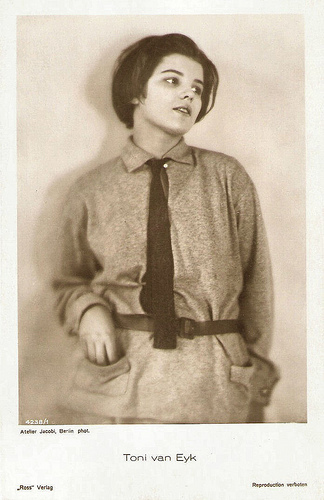
German postcard by Ross Verlag, no. 4238/1, 1929-1930. Photo: Atelier Jacobi, Berlin.
A Woman Branded
Toni (also Tony) van Eyck (van Eyk) was born Gertrud Johanna Antonie Eick in 1910 in Koblenz, Germany.
She took acting lessons at the Max-Reinhardt-Seminar in Wien (Vienna) and at the Otto-Falkenberg-Schule in München (Munich). At the age of 15 she already played at various Berlin stages, and convinced the critics with her performances.
She was discovered for the film in 1928 and appeared in the silent short Ins Blaue hinein/Into the Blue (Eugen Schüfftan, 1929) with Theo Lingen .
After a few more silent films, she became known with her leading role in the early Aufklärungsfilm (education film) Gefahren der Liebe/A Woman Branded (Eugen Thiele, 1931) opposite Hans Stüwe . She played a rape victim, who finally becomes a murderess.
In the following years she appeared in such films as Kitty schwindelt sich ins Glück/Kitty is giddy to happiness (Herbert Juttke, 1932), Strich durch die Rechnung/Spoiling the Game (Alfred Zeisler, 1932) costarring with Heinz Rühmann , Was wissen denn Männer/What Do Men know (Gerhard Lamprecht, 1933), and Herthas Erwachen/Hertha's Awakening (Gerhard Lamprecht, 1933) opposite Hans Brausewetter .
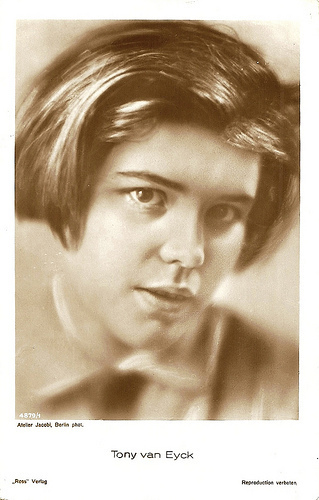
German postcard by Ross Verlag, no. 4879/1, 1929-1930. Photo: Atelier Jacobi, Berlin.
Appeal from the Ether
Despite these successful roles in the early 1930s, Toni van Eyck would stay a theatre actress primarily. From 1938 to 1942 she was part of the ensemble of the famous Burgtheater in Vienna.
After the war, she acted at the Salzburger Landestheater (Salzburg State Theater).
In 1950 she made her last film. She played a small part in the crime drama Ruf aus dem Äther/Appeal from the Ether (Georg C. Klaren, Georg Wilhelm Pabst, 1951) starring Oskar Werner .
Later she worked as a playwright for stage and radio. In 1955 she published her novel, Ein Mann namens Miller (A Man Named Miller). She also continued to appear on stage in guest appearances for a long time.
Toni van Eyck died in 1988.
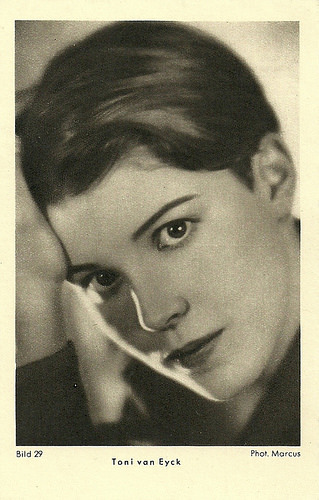
German postcard by Margarinewerk Gebr. Fauser GmbH. Eidelstadt, Holstein. 'Die trustfreie Eidelsan', no. 29. Photo Marcus.
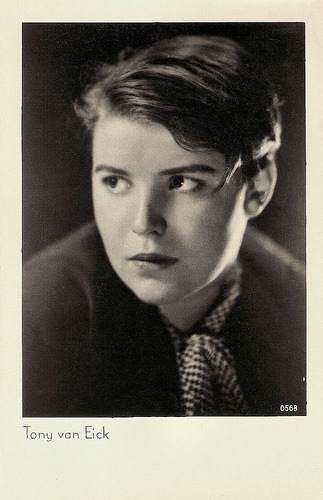
German postcard by Harlip, Berlin, no. 0568.
Sources: Thomas Staedeli (Cyranos), Wikipedia (German), and .

German postcard by Ross Verlag, no. 4238/1, 1929-1930. Photo: Atelier Jacobi, Berlin.
A Woman Branded
Toni (also Tony) van Eyck (van Eyk) was born Gertrud Johanna Antonie Eick in 1910 in Koblenz, Germany.
She took acting lessons at the Max-Reinhardt-Seminar in Wien (Vienna) and at the Otto-Falkenberg-Schule in München (Munich). At the age of 15 she already played at various Berlin stages, and convinced the critics with her performances.
She was discovered for the film in 1928 and appeared in the silent short Ins Blaue hinein/Into the Blue (Eugen Schüfftan, 1929) with Theo Lingen .
After a few more silent films, she became known with her leading role in the early Aufklärungsfilm (education film) Gefahren der Liebe/A Woman Branded (Eugen Thiele, 1931) opposite Hans Stüwe . She played a rape victim, who finally becomes a murderess.
In the following years she appeared in such films as Kitty schwindelt sich ins Glück/Kitty is giddy to happiness (Herbert Juttke, 1932), Strich durch die Rechnung/Spoiling the Game (Alfred Zeisler, 1932) costarring with Heinz Rühmann , Was wissen denn Männer/What Do Men know (Gerhard Lamprecht, 1933), and Herthas Erwachen/Hertha's Awakening (Gerhard Lamprecht, 1933) opposite Hans Brausewetter .

German postcard by Ross Verlag, no. 4879/1, 1929-1930. Photo: Atelier Jacobi, Berlin.
Appeal from the Ether
Despite these successful roles in the early 1930s, Toni van Eyck would stay a theatre actress primarily. From 1938 to 1942 she was part of the ensemble of the famous Burgtheater in Vienna.
After the war, she acted at the Salzburger Landestheater (Salzburg State Theater).
In 1950 she made her last film. She played a small part in the crime drama Ruf aus dem Äther/Appeal from the Ether (Georg C. Klaren, Georg Wilhelm Pabst, 1951) starring Oskar Werner .
Later she worked as a playwright for stage and radio. In 1955 she published her novel, Ein Mann namens Miller (A Man Named Miller). She also continued to appear on stage in guest appearances for a long time.
Toni van Eyck died in 1988.

German postcard by Margarinewerk Gebr. Fauser GmbH. Eidelstadt, Holstein. 'Die trustfreie Eidelsan', no. 29. Photo Marcus.

German postcard by Harlip, Berlin, no. 0568.
Sources: Thomas Staedeli (Cyranos), Wikipedia (German), and .
Published on January 14, 2015 22:00
January 13, 2015
Atelier Balázs
Today, the subject of our series on film star photographers is Atelier Balázs. This little known Berlin studio was active during the Weimar period. The photographs of Atelier Balázs were often used for the sepia postcards of Ross Verlag.
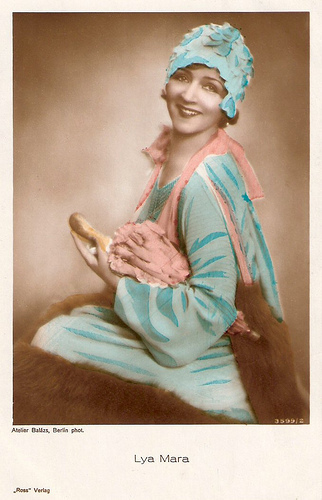
Lya Mara . German postcard by Ross Verlag, no. 3599/2, 1928-1929. Photo: Atelier Balázs, Berlin.
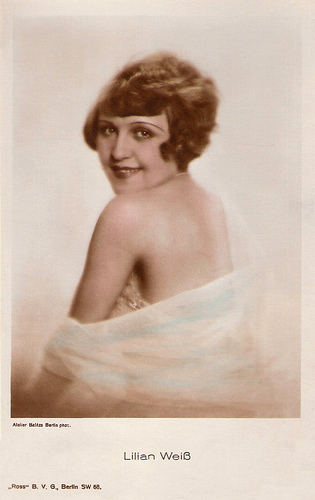
Lilian Weiss. German postcard by Ross Verlag, Berlin. Photo: Atelier Balázs, Berlin.
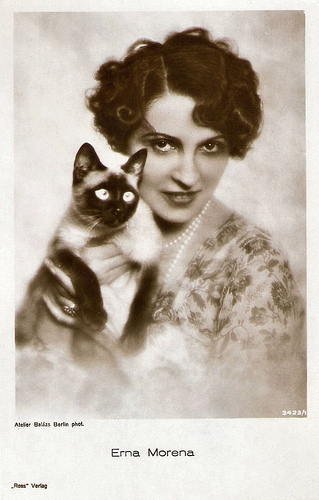
Erna Morena . German postcard by Ross Verlag, no. 3423/1, 1928-1929. Photo: Atelier Balázs, Berlin.
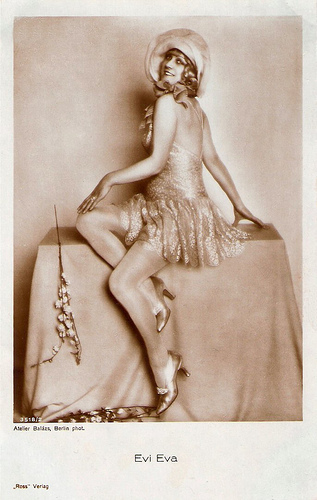
Evi Eva . German postcard by Ross Verlag, no. 3518/2, 1928-1929. Photo: Atelier Balázs, Berlin.
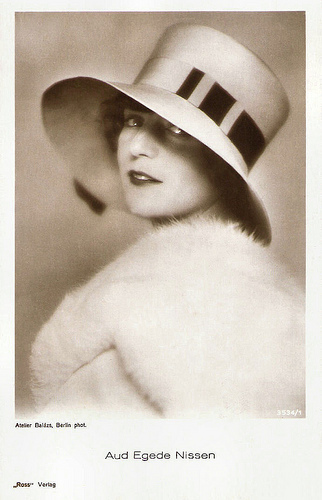
Aud Egede Nissen . German postcard. by Ross Verlag, Berlin, no. 3534/1, 1928-1929. Photo: Atelier Balázs, Berlin.
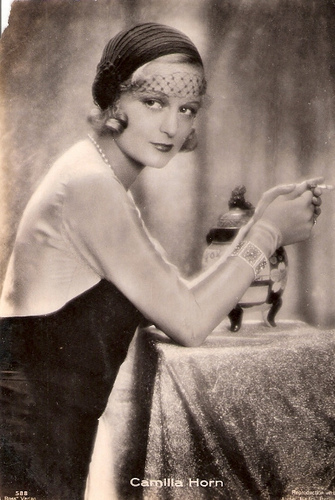
Camilla Horn . German postcard by Ross Verlag, no. 588. Photo: Atelier Balázs, Berlin.
The visible man
Although Atelier Balázs contributed several portraits to the postcards of Ross Verlag, there is nothing known about the studio, The WikiProjekt Stummfilm/Stummfilmfotografen has not identified yet who Balázs was, when he or she was born and where.
Most of the photos are made in the second part of the 1920s. The studio was active in the German capital at the same time as film critic, screen writer and director Béla Balázs. Were they connected?
Béla Balázs (1884-1949) was born as Herbert Bauer in Szeged in Austria-Hungary (now Hungary). He was the son of Jewish German-born parents, adopting his nom de plume in newspaper articles written before his 1902 move to Budapest, where he studied Hungarian and German at the Eötvös Collegium.
The collapse of the short-lived Hungarian Soviet Republic under Béla Kun in 1919 began a long period of exile in Vienna and Germany and, from 1933 until 1945, the Soviet Union.
In Vienna he became a prolific writer of film reviews. His first book on film, Der Sichtbare Mensch (The Visible Man) (1924), helped found the German 'film as a language' theory, which influenced directors Sergei Eisenstein and Vsevolod Pudovkin.
A popular consultant, he wrote the screenplay for G. W. Pabst's film of Die Dreigroschenoper/The Three Penny Opera (1931), which became the object of a scandal and lawsuit by Brecht (who admitted to not reading the script) during production.
Later, he and Carl Mayer co-wrote Leni Riefenstahl 's Das Blaue Licht/The blue light (1932). He also helped Riefenstahl to direct the film, but she later removed his and Mayer's name from the credits because they were Jewish.
After the war, he returned to Hungary to help rebuild the film industry there. One of his best known films is Valahol Európában/Somewhere in Europe (Géza von Radványi, 1947).
Was Atelier Balázs a side job for Béla Balázs? Probably not, while he moved to Berlin in 1926, and some of the portraits, like the one for Karl Beckersachs were already made in the years before. But who was the photographer behind Atelier Balázs then?
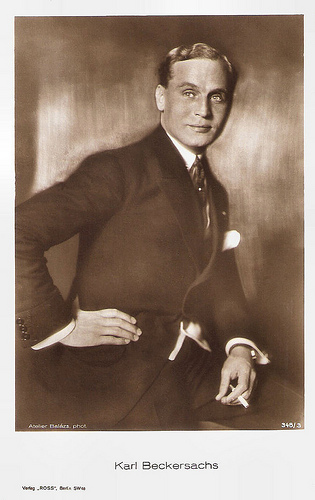
Karl Beckersachs . German postcard by Ross Verlag, Berlin, no. 348/3, 1919-1924. Photo: Atelier Balász.
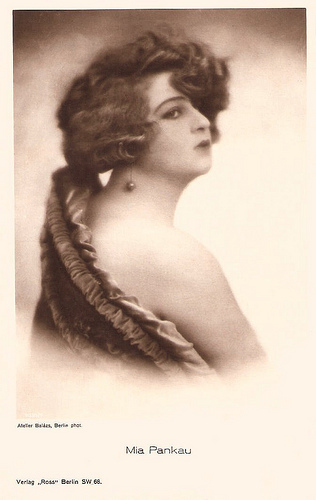
Mia Pankau . German postcard by Ross Verlag, nr. 1031/1, 1927-1928. Photo: Atelier Balázs, Berlin.
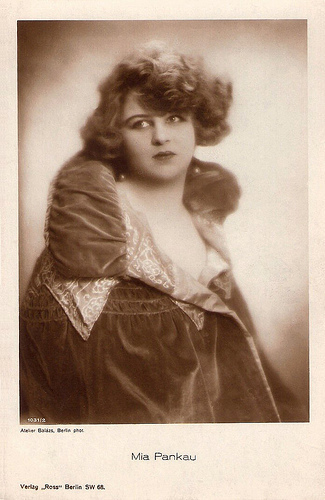
Mia Pankau . German postcard by Ross Verlag, no. 1031/2, 1927-1928. Photo: Atelier Balázs, Berlin.
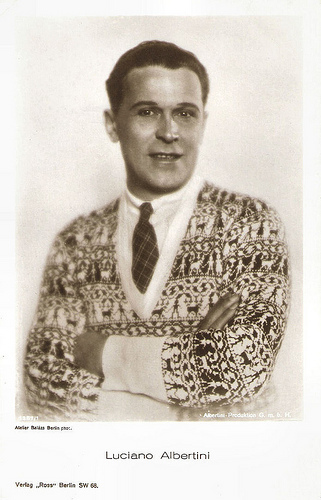
Luciano Albertini . German postcard by Ross Verlag, no. 1287/1, 1927-1928. Photo: Atelier Balázs, Berlin / Albertini-Produktion GmbH.
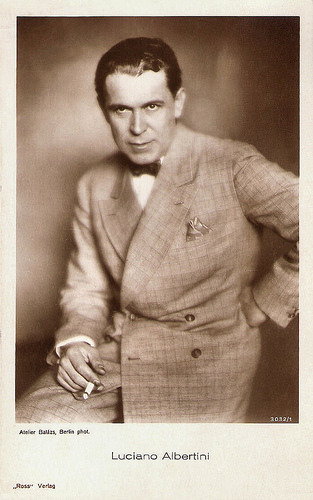
Luciano Albertini . German postcard by Ross Verlag, no. 3032/1, 1928-1929. Photo: Atelier Balázs, Berlin. This picture was also used for the cover of the magazine Film-Woche, no. 17, 1929, to announce Albertini's film Tempo! Tempo! (Max Obal, 1929).
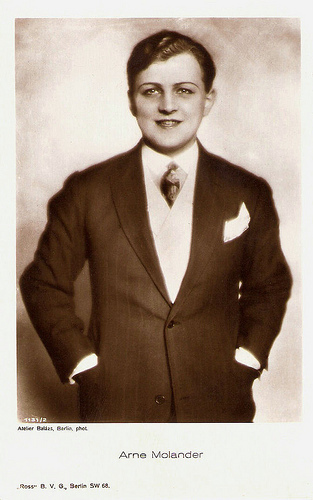
Arne Molander . German Postcard by Ross Verlag, Berlin, no. 1131/2, 1927-1928. Photo: Atelier Balázs, Berlin.
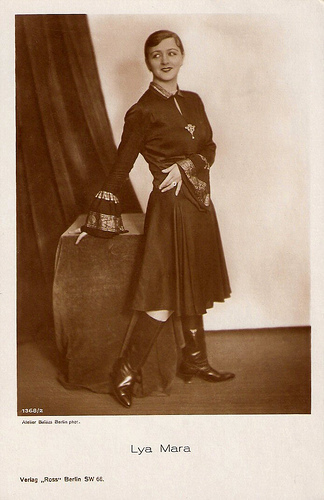
Lya Mara . German postcard by Ross Verlag, no. 1368/2, 1927-1928. Photo: Atelier Balázs, Berlin.
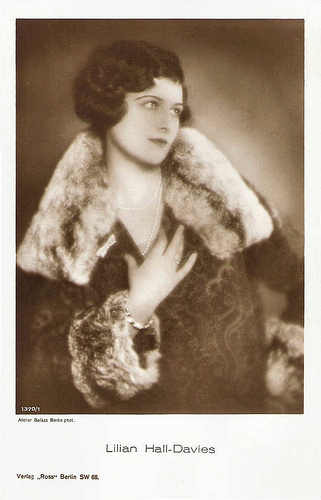
Lilian Hall-Davis . German postcard by Ross Verlag, Berlin, no. 1370/1, 1927-1928. Photo: Atelier Balázs, Berlin.
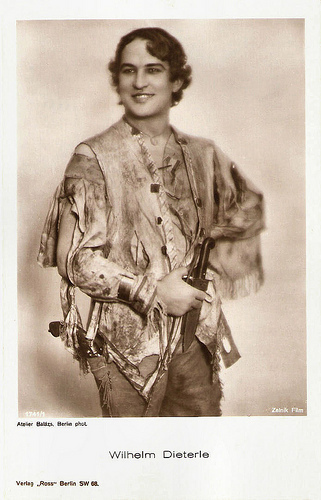
Wilhelm Dieterle . German postcard by Ross Verlag, no. 1741/1, 1927-1928. Photo: Atelier Balázs, Berlin / Zelnik Film.
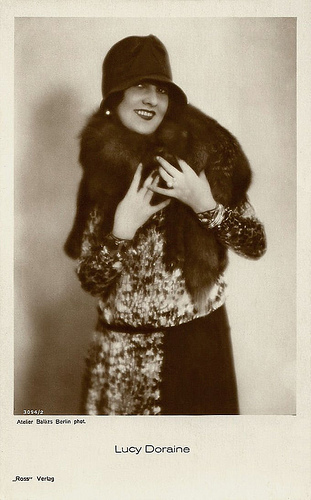
Lucy Doraine. German postcard by Ross Verlag, no. 3054/2, 1928-1929. Photo: Atelier Balázs, Berlin.
Check out our other posts on film star photographers. See the links at right under the caption 'The Photographers'.
Sources: Wikipedia.

Lya Mara . German postcard by Ross Verlag, no. 3599/2, 1928-1929. Photo: Atelier Balázs, Berlin.

Lilian Weiss. German postcard by Ross Verlag, Berlin. Photo: Atelier Balázs, Berlin.

Erna Morena . German postcard by Ross Verlag, no. 3423/1, 1928-1929. Photo: Atelier Balázs, Berlin.

Evi Eva . German postcard by Ross Verlag, no. 3518/2, 1928-1929. Photo: Atelier Balázs, Berlin.

Aud Egede Nissen . German postcard. by Ross Verlag, Berlin, no. 3534/1, 1928-1929. Photo: Atelier Balázs, Berlin.

Camilla Horn . German postcard by Ross Verlag, no. 588. Photo: Atelier Balázs, Berlin.
The visible man
Although Atelier Balázs contributed several portraits to the postcards of Ross Verlag, there is nothing known about the studio, The WikiProjekt Stummfilm/Stummfilmfotografen has not identified yet who Balázs was, when he or she was born and where.
Most of the photos are made in the second part of the 1920s. The studio was active in the German capital at the same time as film critic, screen writer and director Béla Balázs. Were they connected?
Béla Balázs (1884-1949) was born as Herbert Bauer in Szeged in Austria-Hungary (now Hungary). He was the son of Jewish German-born parents, adopting his nom de plume in newspaper articles written before his 1902 move to Budapest, where he studied Hungarian and German at the Eötvös Collegium.
The collapse of the short-lived Hungarian Soviet Republic under Béla Kun in 1919 began a long period of exile in Vienna and Germany and, from 1933 until 1945, the Soviet Union.
In Vienna he became a prolific writer of film reviews. His first book on film, Der Sichtbare Mensch (The Visible Man) (1924), helped found the German 'film as a language' theory, which influenced directors Sergei Eisenstein and Vsevolod Pudovkin.
A popular consultant, he wrote the screenplay for G. W. Pabst's film of Die Dreigroschenoper/The Three Penny Opera (1931), which became the object of a scandal and lawsuit by Brecht (who admitted to not reading the script) during production.
Later, he and Carl Mayer co-wrote Leni Riefenstahl 's Das Blaue Licht/The blue light (1932). He also helped Riefenstahl to direct the film, but she later removed his and Mayer's name from the credits because they were Jewish.
After the war, he returned to Hungary to help rebuild the film industry there. One of his best known films is Valahol Európában/Somewhere in Europe (Géza von Radványi, 1947).
Was Atelier Balázs a side job for Béla Balázs? Probably not, while he moved to Berlin in 1926, and some of the portraits, like the one for Karl Beckersachs were already made in the years before. But who was the photographer behind Atelier Balázs then?

Karl Beckersachs . German postcard by Ross Verlag, Berlin, no. 348/3, 1919-1924. Photo: Atelier Balász.

Mia Pankau . German postcard by Ross Verlag, nr. 1031/1, 1927-1928. Photo: Atelier Balázs, Berlin.

Mia Pankau . German postcard by Ross Verlag, no. 1031/2, 1927-1928. Photo: Atelier Balázs, Berlin.

Luciano Albertini . German postcard by Ross Verlag, no. 1287/1, 1927-1928. Photo: Atelier Balázs, Berlin / Albertini-Produktion GmbH.

Luciano Albertini . German postcard by Ross Verlag, no. 3032/1, 1928-1929. Photo: Atelier Balázs, Berlin. This picture was also used for the cover of the magazine Film-Woche, no. 17, 1929, to announce Albertini's film Tempo! Tempo! (Max Obal, 1929).

Arne Molander . German Postcard by Ross Verlag, Berlin, no. 1131/2, 1927-1928. Photo: Atelier Balázs, Berlin.

Lya Mara . German postcard by Ross Verlag, no. 1368/2, 1927-1928. Photo: Atelier Balázs, Berlin.

Lilian Hall-Davis . German postcard by Ross Verlag, Berlin, no. 1370/1, 1927-1928. Photo: Atelier Balázs, Berlin.

Wilhelm Dieterle . German postcard by Ross Verlag, no. 1741/1, 1927-1928. Photo: Atelier Balázs, Berlin / Zelnik Film.

Lucy Doraine. German postcard by Ross Verlag, no. 3054/2, 1928-1929. Photo: Atelier Balázs, Berlin.
Check out our other posts on film star photographers. See the links at right under the caption 'The Photographers'.
Sources: Wikipedia.
Published on January 13, 2015 22:00
January 12, 2015
Karl Martell
Karl Martell (1906-1966) was an incisive, debonair German supporting actor of the 1930s and 1940s. He often played in authoritarian roles in prestige Ufa productions, including four films with Zarah Leander. After the war, he worked as a documentary film maker with his own company.
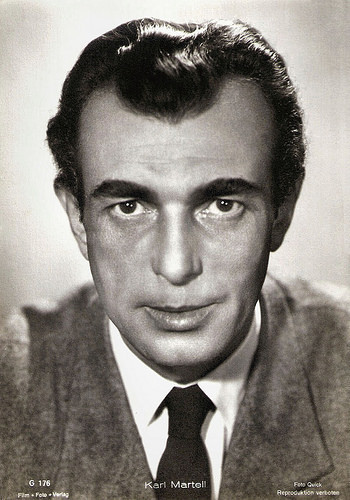
German postcard by Film-Foto-Verlag, no. G 176. Photo: Quick.
Dazzling appearance, but no charisma
Karl Hermann Martell was born in Tilsit, Germany (now Sovetsk, Russia) in 1906. He was born in a bourgeois, military family.
Already at the age of 13, Karl made his film debut in the silent film Das große Geheimnis/The big secret (Herbert Gerdes, 1920). ( Filmportal.de also mentions Die Tragödie der Manja Orsan/The tragedy of Manja Orsan (Richard Eichberg, 1919) with Charles Willy Kayser and Ruth Weyher as his debut, but this must be an error while Martell’s part in this film is described as a theatre director).
His debut was followed by parts in silent films like Die goldene Pest/The Golden Plague (Louis Ralph, Richard Oswald, 1921) with Anita Berber , and Das goldene Haar/The Golden Hair (Bruno Eichgrün, 1922).
In the following years, he studied acting at the Max-Reinhardt-Schule. In the 1930s, he became a well known film actor, often playing officers or aristocrats. In one of his first films as an adult, he played opposite Swedish stage and screen star Zarah Leander in the Austrian backstage musical Première (Géza von Bolváry, 1937), which became an enormous box office hit. It was Leander's first German language role, and she was immediately signed by the Ufa.
For a long time, Martell was considered Zarah Leander 's ideal film partner. Among his best known films of the 1930s are La Habanera/Cheated by the Wind (Detlef Sierck a.k.a. Douglas Sirk, 1937) again with Leander and another box office success, Der Spieler/The Player (Gerhard Lamprecht, 1938) based on the novel by Fyodor Dostoevsky, and the Western Frauen für Golden Hill/Women for Golden Hill (Erich Waschneck, 1938).
Stephanie D’heil at Steffi-Line : “Although Karl Martell also worked with other female audience favourites, for example with Camilla Horn in the sentimental thriller Gauner im frack/Rogue in Tuxedo (Johannes Riemann, 1937), he never achieved Zarah Leander ’s star status. The reason is probably that he lacked a certain charisma and despite his dazzling appearance, his performances always seemed rather ‘pale’.”
At CinéArtistes , Philippe Pelletier writes however that “In 1939, Martell embodies the very convincing Lieutenant Ludwig Becker in D III 38, a war drama by Herbert Maisch.”
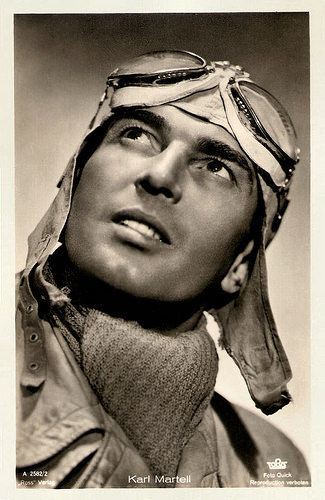
German postcard by Film-Foto-Verlag, no. A 2582/2, 1939-1940. Photo: Quick / Tobis.
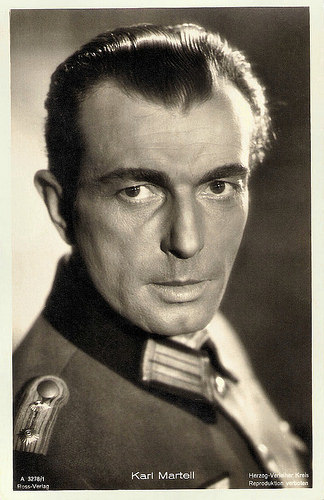
German postcard by Ross Verlag, no. A 3278/1, 1941-1944. Photo: Herzog-Verleiher Kreis.
Convicted for collaboration
During the Second World War, Karl Martell played in such films as the crime film Alarm (Herbert B. Fredersdorf, 1941), the controversial biopic Ohm Krüger (Hans Steinhoff, Karl Anton, 1941) featuring Emil Jannings as Transvaal politician Paul Krüger, Damals/Those Days (Rolf Hansen, 1943) with Zarah Leander , and Das alte Lied/The old song (Fritz Peter Buch, 1945) starring Winnie Markus .
After the end of the war, Martell was convicted for his collaboration with the Nazi regime and his participation in various propaganda films. He was sentenced to a ban on acting for several years.
In the 1950s, Martell only worked only incidentally for the cinema in mostly forgettable productions. Among these later films are the melodrama Herzen im Sturm/Hearts by storm (Jürgen von Alten, 1951), the adventure film Die Gefangene des Maharadscha/Circus Girl (Veit Harlan, 1953), and its sequel Sterne über Colombo/Stars on Colombo (Veit Harlan, 1954).
From the early 1950s on, Martell also made documentaries for his own production company in Hamburg.
In 1959, he returned in front of the camera for a minor role in Der blaue Nachtfalter/The blue Moth (Wolfgang Schleif 1959), in which he was reunited with Zarah Leander . Then he retired from the film business.
Forgotten and alone, Karl Martell died in 1966 in Hamburg, Germany. He was 60.
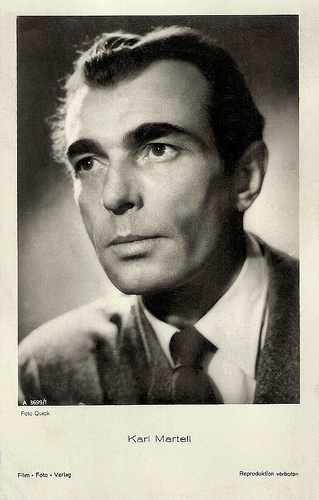
German postcard by Film-Foto-Verlag, no. A 3699/1, 1941-1944. Photo: Quick.
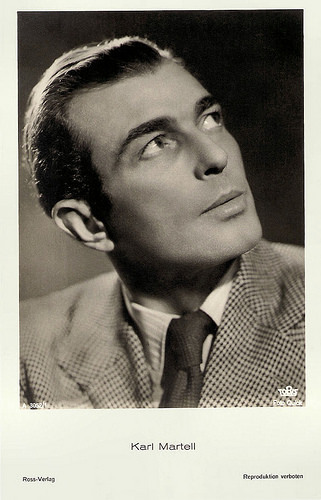
German postcard by Ross Verlag, no. A 3052/1, 1941-1944. Photo: Tobis / Quick.
Theatrical Trailer La Habanera (1937). Source: Ordner481 (YouTube).
Sources: Philippe Pelletier (CinéArtistes – French), Stephanie d’Heil (Steffi-Line - German), Hal Erickson (AllMovie), Thomas Staedeli (Cyranos), Filmportal.de, Wikipedia (German and English) and .

German postcard by Film-Foto-Verlag, no. G 176. Photo: Quick.
Dazzling appearance, but no charisma
Karl Hermann Martell was born in Tilsit, Germany (now Sovetsk, Russia) in 1906. He was born in a bourgeois, military family.
Already at the age of 13, Karl made his film debut in the silent film Das große Geheimnis/The big secret (Herbert Gerdes, 1920). ( Filmportal.de also mentions Die Tragödie der Manja Orsan/The tragedy of Manja Orsan (Richard Eichberg, 1919) with Charles Willy Kayser and Ruth Weyher as his debut, but this must be an error while Martell’s part in this film is described as a theatre director).
His debut was followed by parts in silent films like Die goldene Pest/The Golden Plague (Louis Ralph, Richard Oswald, 1921) with Anita Berber , and Das goldene Haar/The Golden Hair (Bruno Eichgrün, 1922).
In the following years, he studied acting at the Max-Reinhardt-Schule. In the 1930s, he became a well known film actor, often playing officers or aristocrats. In one of his first films as an adult, he played opposite Swedish stage and screen star Zarah Leander in the Austrian backstage musical Première (Géza von Bolváry, 1937), which became an enormous box office hit. It was Leander's first German language role, and she was immediately signed by the Ufa.
For a long time, Martell was considered Zarah Leander 's ideal film partner. Among his best known films of the 1930s are La Habanera/Cheated by the Wind (Detlef Sierck a.k.a. Douglas Sirk, 1937) again with Leander and another box office success, Der Spieler/The Player (Gerhard Lamprecht, 1938) based on the novel by Fyodor Dostoevsky, and the Western Frauen für Golden Hill/Women for Golden Hill (Erich Waschneck, 1938).
Stephanie D’heil at Steffi-Line : “Although Karl Martell also worked with other female audience favourites, for example with Camilla Horn in the sentimental thriller Gauner im frack/Rogue in Tuxedo (Johannes Riemann, 1937), he never achieved Zarah Leander ’s star status. The reason is probably that he lacked a certain charisma and despite his dazzling appearance, his performances always seemed rather ‘pale’.”
At CinéArtistes , Philippe Pelletier writes however that “In 1939, Martell embodies the very convincing Lieutenant Ludwig Becker in D III 38, a war drama by Herbert Maisch.”

German postcard by Film-Foto-Verlag, no. A 2582/2, 1939-1940. Photo: Quick / Tobis.

German postcard by Ross Verlag, no. A 3278/1, 1941-1944. Photo: Herzog-Verleiher Kreis.
Convicted for collaboration
During the Second World War, Karl Martell played in such films as the crime film Alarm (Herbert B. Fredersdorf, 1941), the controversial biopic Ohm Krüger (Hans Steinhoff, Karl Anton, 1941) featuring Emil Jannings as Transvaal politician Paul Krüger, Damals/Those Days (Rolf Hansen, 1943) with Zarah Leander , and Das alte Lied/The old song (Fritz Peter Buch, 1945) starring Winnie Markus .
After the end of the war, Martell was convicted for his collaboration with the Nazi regime and his participation in various propaganda films. He was sentenced to a ban on acting for several years.
In the 1950s, Martell only worked only incidentally for the cinema in mostly forgettable productions. Among these later films are the melodrama Herzen im Sturm/Hearts by storm (Jürgen von Alten, 1951), the adventure film Die Gefangene des Maharadscha/Circus Girl (Veit Harlan, 1953), and its sequel Sterne über Colombo/Stars on Colombo (Veit Harlan, 1954).
From the early 1950s on, Martell also made documentaries for his own production company in Hamburg.
In 1959, he returned in front of the camera for a minor role in Der blaue Nachtfalter/The blue Moth (Wolfgang Schleif 1959), in which he was reunited with Zarah Leander . Then he retired from the film business.
Forgotten and alone, Karl Martell died in 1966 in Hamburg, Germany. He was 60.

German postcard by Film-Foto-Verlag, no. A 3699/1, 1941-1944. Photo: Quick.

German postcard by Ross Verlag, no. A 3052/1, 1941-1944. Photo: Tobis / Quick.
Theatrical Trailer La Habanera (1937). Source: Ordner481 (YouTube).
Sources: Philippe Pelletier (CinéArtistes – French), Stephanie d’Heil (Steffi-Line - German), Hal Erickson (AllMovie), Thomas Staedeli (Cyranos), Filmportal.de, Wikipedia (German and English) and .
Published on January 12, 2015 22:00
January 11, 2015
Anita Ekberg (1931-2015)
Swedish (but naturalized Italian) film actress Anita Ekberg has passed away today. As Miss Sweden 1950, she was contracted by Howard Hughes, had a Hollywood career in the 1950s, but got her real breakthrough in Italy. She made film history as the sensual, curvaceous film goddess who dances in the Trevi Fountain in Fellini’s La Dolce Vita (1960). She was also unforgettable as a sexy billboard figure coming to life in Fellini's short film La Tentazioni del Dottor Antonio/The Temptation of Doctor Antonio (1962). Anita Ekberg was 83 years old.
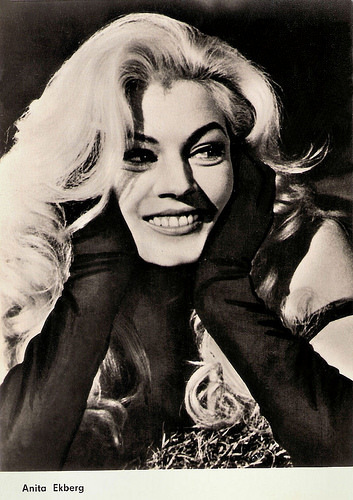
East-German postcard by VEB Progress FilmVertrieb, Berlin, no. 2391, 1965. Photo: publicity still for Boccaccio '70 (Federico Fellini, 1962).
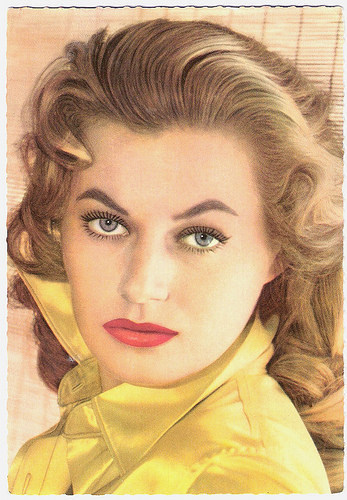
German postcard by ISV, no. F 10.
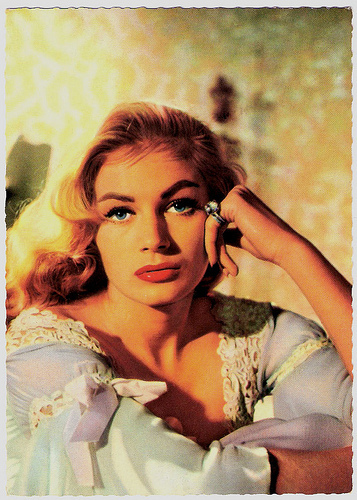
German postcard by ISV, no. D 8. Photo: Pierluigi.
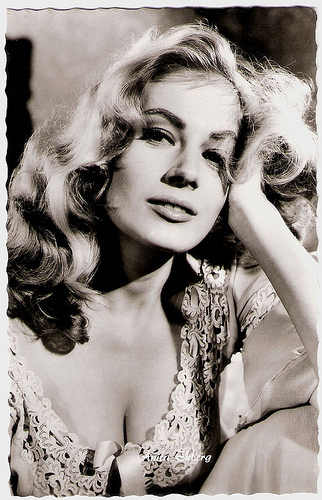
German postcard by Kolibri-Verlag, Minden/Westf., no. 150.
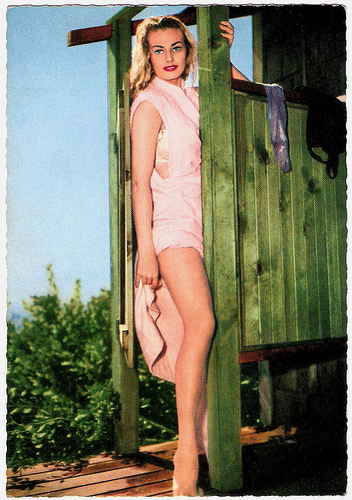
German postcard by ISV, Sort. VI/6.
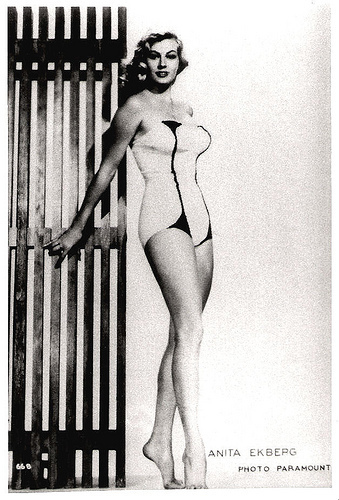
Collector's card, no. 668. Photo: Paramount.
Miss Sweden
Kerstin Anita Marianne Ekberg was born in Malmö, Sweden in 1931. She grew up with seven brothers and sisters. Having six brothers around surely developed a fierce independent spirit.
In her teens, she worked as a fashion model, and in 1951 she was elected Miss Sweden. That year she also made her film début in the film journal Terras fönster nr 5/Terra Journal No. 5 (Olle Ekelund, 1951), and she went to the US for the Miss Universe contest, despite not speaking English. She didn't win but she got a modelling contract.
Film mogul Howard Hughes gave her a contract with RKO but it didn't lead anywhere. Anita herself later claimed that Hughes wanted to marry her. Instead the voluptuous, husky-voiced blonde started making films for Universal.
Her American début was as a Venusian guard in Abbott and Costello Go to Mars (Charles Lamont, 1953). This was soon followed by The Golden Blade (Nathan Juran, 1953) starring Rock Hudson. These were small roles that only required her to look beautiful. She was given the nickname ‘The Iceberg’ - a play on her name as well as her cool, quite mysterious demeanour.
While at Universal, Anita Ekberg quickly became one of Hollywood’s hot starlets. She caught the hearts of many famous men including Tyrone Power, Errol Flynn, Frank Sinatra and Gary Cooper. Legendary director and photographer Russ Meyer called her 'the most beautiful woman he ever photographed' and said that her 40D bust line was 'the most ample in A list Hollywood history, dwarfing rivals like Jayne Mansfield '.
Soon she became a major pin up girl for the new type of men's magazine such as Playboy that proliferated in the 1950s. Ekberg also knew how to play the Hollywood tabloids and gossip columnists, creating stunts that she hoped would translate into film roles. Famously, she admitted that an incident where her dress burst open in the lobby of London's Berkeley Hotel was pre-arranged with a photographer.
Her two marriages also gave her a lot of attention from the press. She married and divorced British actor Anthony Steel (1956-1959) and actor Rik Van Nutter (1963-1975). And she reportedly had a three-year affair with the late Fiat chairman Gianni Agnelli.
The press also loved her saucy quotes, like: “I'm very proud of my breasts, as every woman should be. It's not cellular obesity. It's womanliness.”
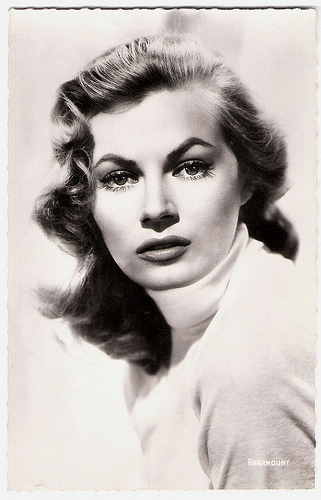
French postcard by Editions du Globe (EDUG), no. 521. Photo: Paramount.
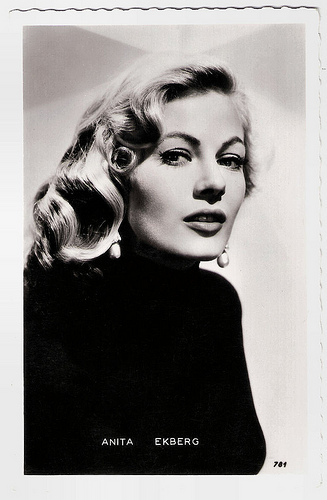
French postcard by Editions P.I., Paris, no. 781. Photo: Paramount.
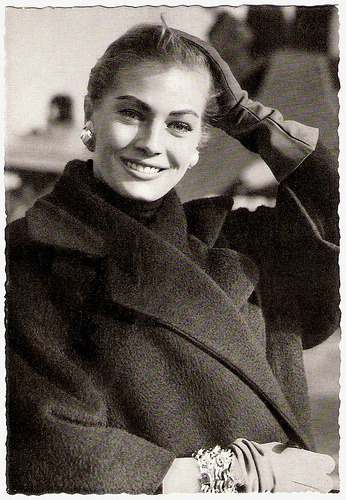
German postcard by WS-Druck, Wanne-Eickel, no. 203. Photo: dpa.
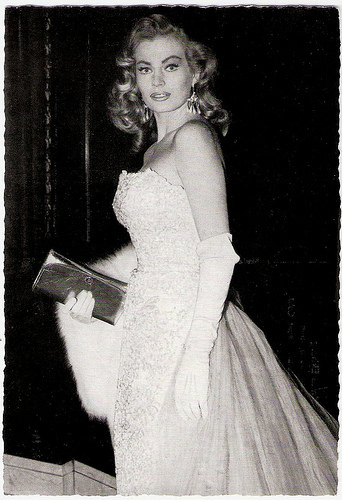
German postcard by WS-Druck, Wanne-Eickel, no. 181. Photo: dpa.
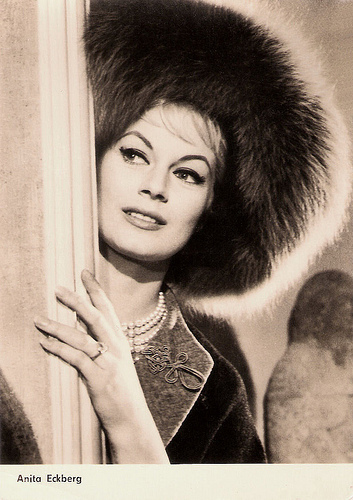
East-German postcard by VEB Progress Film-vertrieb, Berlin, no. 3171, 1968. Retail price: 0,20 M. Photo: Pierluigi.
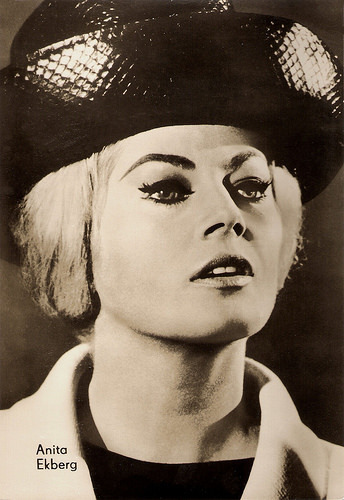
Big East-German card by VEB Progress Film-Vertrieb, Berlin, no. 262/69.
Foil for Sight Gags
Anita Ekberg would get several offers from other studios than Universal. Bob Hope joked that her parents had received the Nobel Prize for architecture when he was touring with her and William Holden to entertain US troops in 1954.
The tour led her to a contract with John Wayne's Batjac Productions. Wayne cast her in Blood Alley (William A. Wellman, 1955), a small role where Ekberg's features and appearance were Orientalized to play a Chinese woman. The role earned her a Golden Globe award.
Paramount Pictures then cast her in the funny comedies Artists and Models (Frank Tashlin, 1955) and Hollywood or Bust (Frank Tashlin, 1956), both starring Dean Martin and Jerry Lewis. These films showed off her stunning body but also used her as a foil for many of the director's clever sight gags.
In 1956, Ekberg went to Rome to make War and Peace (King Vidor, 1956) co-starring Audrey Hepburn . RKO gave Ekberg the female lead in Back from Eternity (John Farrow, 1956), co-starring with Robert Ryan and Rod Steiger. Ekberg was perfectly adequate in her cardboard role, and suggested that with a good director and a worthwhile part, she might have something to offer.
In the British production Zarak (Terence Young, 1956) starring Victor Mature and Michael Wilding, her sexy harem-girl dance raised many eyebrows and blood pressures. With Bob Hope she made two minor comedies, Paris Holiday (Gerd Oswald, 1958) and Call Me Bwana (Gordon Douglas, 1963).
One of her better films of this period was the film noir Screaming Mimi (Gerd Oswald, 1958). At IMDb , reviewer Lazarillo calls it one of "the missing link between American film noir and the suspense and horror films that would become so popular in continental Europe over the next two decades (i.e. the German 'krimis', the Italian 'gialli', the horror films of Bava and Argento). It's technically a late period film noir, but rather than having the traditional pessimistic tone and hard-boiled, voice-over narrative, it is completely off-the-wall and chock-full of the suggested depravity and lurid psycho-babble that would characterize the later European films. Interestingly, it was apparently based on the same Fredric Brown novel as Dario Argento's Bird with Crystal Plummage."
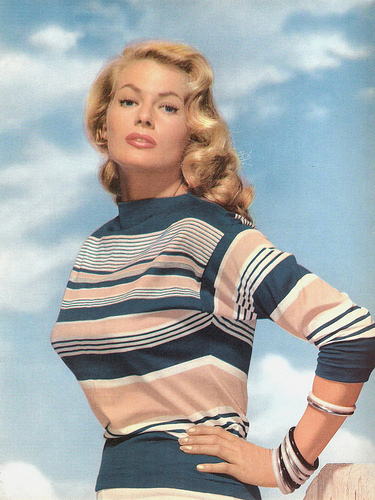
Vintage postcard.
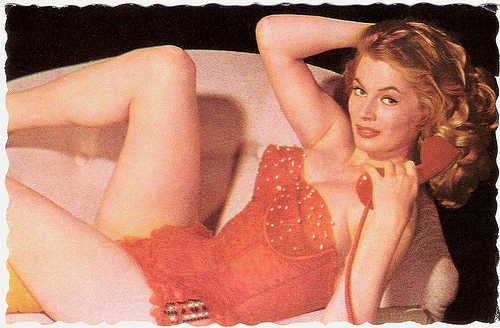
French postcard by De Marchi Frères, Marseille.
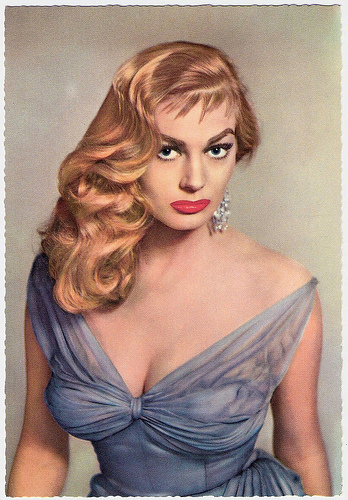
German postcard by ISV, no. H 23.
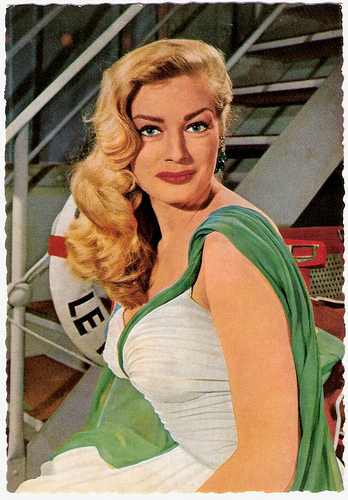
German postcard by WS-Druck, Wanne-Eickel. Photo: Klaus Collignon.
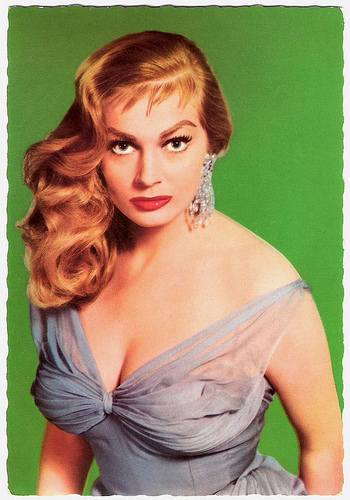
French postcard by EDUG, no. 151.
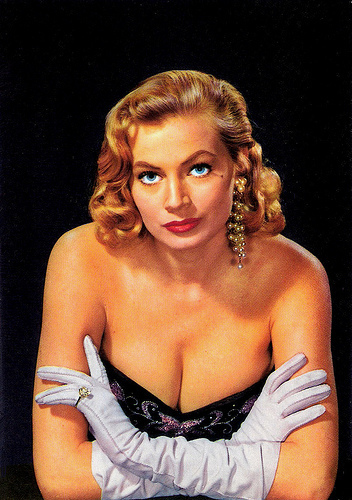
Italian postcard by Rotalcolor, Milano, no. N. 51.
The Sweet Life
In 1960 Anita Ekberg found herself again in Rome for her greatest role. She played the unattainable ‘dream woman’ Sylvia opposite Marcello Mastroianni in Federico Fellini's La Dolce Vita/The Sweet Life (1960). La Dolce Vita was a sensational success, and Ekberg's uninhibited cavorting in Rome's Trevi Fountain remains one of the most memorable screen images ever captured.
Thus began a period when Ekberg would work almost exclusively in Europe. La Dolce Vita was followed by another memorable role for Fellini in his segment La Tentazioni del Dottor Antonio/The Temptation of Doctor Antonio of the anthology film Boccaccio '70 (1962). She plays a gigantic voluptuous lady on a billboard poster, promoting to drink milk and attracting huge crowds. At night she comes to live and pesters the little censor, played by Peppino De Filippo .
Fellini would later call her back for two more films: I Pagliacci/I clowns (Federico Fellini, 1972), and Intervista (Federico Fellini, 1987).
In 1964 she returned to Sweden to appear in Bo Widerberg's Kärlek 65/Love 65 (1965), but she cancelled her appearance and called the acclaimed director ‘an amateur’.
In 1967 she co-starred with Shirley MacLaine in a segment of Vittorio de Sica ’s Woman Times Seven (1967). For much of the 1960s though, she was trapped in substandard genre fare and lame comedies.
During the 1970s the roles became less frequent. In 1982, at the age of 50 she posed for glamour photos but in 1987, twenty-seven years after La Dolce Vita, she made a marvellous comeback with Fellini's filmic autobiography, Intervista (Federico Fellini, 1987), where she played herself in a reunion scene with Mastroianni and watched film clips of herself during her heydays. In 1995 Empire magazine chose her as one of the 100 Sexiest Stars in film history (#98).
While she remained active in films into the 1990s, the roles were hardly memorable. Exceptions came with her portrayal of an elderly restaurant owner who is killed in a gas explosion in Bámbola/Doll (Bigas Luna, 1996) featuring Valeria Marini, and her role as an ageing, flamboyant opera star who succumbs to the charms of the titular character in Le nain rouge/The Red Dwarf (Yvan Lemoine, 1998). Still blonde, but a bit heavier, Ekberg was able to project the requisite sensuality and diva-like behaviour resulting in a full-bodied performance that ranked among her best.
Her last role in a TV series was in Il bello delle donne/The beautiful one of the women (2002) starring Stefania Sandrelli.
Anita Ekberg has not lived in Sweden since the early 1950s and rarely visited the country. She has welcomed Swedish journalists in her house outside Rome, and in 2005 appeared in the popular radio program Sommar, talking about her life. She stated in an interview that she would never move back to Sweden until she died, when she will be buried there.
Today, 11 January 2015, Anita Ekberg died at the clinic San Raffaele in Rocca di Papa, Italy. Her death was caused by complications from a long-time illness. She was 83.
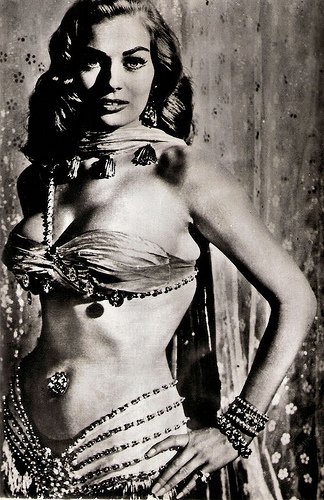
Yugoslavian postcard by Studio Sombor, no. 270.
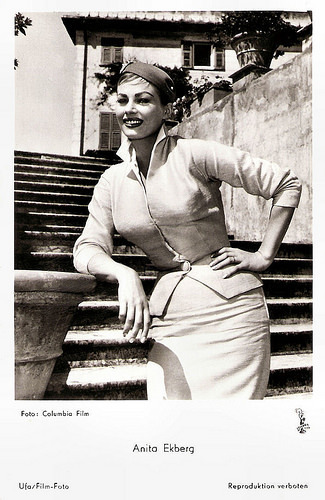
German postcard by Ufa, Berlin-Tempelhof, no. FK 3590. Photo: Columbia Film. Publicity still for Interpol (John Gilling, 1957).
Trailer Artists and Models (1955). Source: Arnold Zieffel (YouTube).
Anita does a sexy dance in the thriller Screaming Mimi (1958). Source: Bachflat (YouTube).
The famous Trevi Gountain scene in La dolce vita (1960). Source: Julia Barnum (YouTube).
Trailer Intervista (1987). Source: Buen Cine Dvd (YouTube).
Sources: Hal Erickson (Rovi), (IMDb), Java’s Bachelor Pad, TCM, Wikipedia, and .

East-German postcard by VEB Progress FilmVertrieb, Berlin, no. 2391, 1965. Photo: publicity still for Boccaccio '70 (Federico Fellini, 1962).

German postcard by ISV, no. F 10.

German postcard by ISV, no. D 8. Photo: Pierluigi.

German postcard by Kolibri-Verlag, Minden/Westf., no. 150.

German postcard by ISV, Sort. VI/6.

Collector's card, no. 668. Photo: Paramount.
Miss Sweden
Kerstin Anita Marianne Ekberg was born in Malmö, Sweden in 1931. She grew up with seven brothers and sisters. Having six brothers around surely developed a fierce independent spirit.
In her teens, she worked as a fashion model, and in 1951 she was elected Miss Sweden. That year she also made her film début in the film journal Terras fönster nr 5/Terra Journal No. 5 (Olle Ekelund, 1951), and she went to the US for the Miss Universe contest, despite not speaking English. She didn't win but she got a modelling contract.
Film mogul Howard Hughes gave her a contract with RKO but it didn't lead anywhere. Anita herself later claimed that Hughes wanted to marry her. Instead the voluptuous, husky-voiced blonde started making films for Universal.
Her American début was as a Venusian guard in Abbott and Costello Go to Mars (Charles Lamont, 1953). This was soon followed by The Golden Blade (Nathan Juran, 1953) starring Rock Hudson. These were small roles that only required her to look beautiful. She was given the nickname ‘The Iceberg’ - a play on her name as well as her cool, quite mysterious demeanour.
While at Universal, Anita Ekberg quickly became one of Hollywood’s hot starlets. She caught the hearts of many famous men including Tyrone Power, Errol Flynn, Frank Sinatra and Gary Cooper. Legendary director and photographer Russ Meyer called her 'the most beautiful woman he ever photographed' and said that her 40D bust line was 'the most ample in A list Hollywood history, dwarfing rivals like Jayne Mansfield '.
Soon she became a major pin up girl for the new type of men's magazine such as Playboy that proliferated in the 1950s. Ekberg also knew how to play the Hollywood tabloids and gossip columnists, creating stunts that she hoped would translate into film roles. Famously, she admitted that an incident where her dress burst open in the lobby of London's Berkeley Hotel was pre-arranged with a photographer.
Her two marriages also gave her a lot of attention from the press. She married and divorced British actor Anthony Steel (1956-1959) and actor Rik Van Nutter (1963-1975). And she reportedly had a three-year affair with the late Fiat chairman Gianni Agnelli.
The press also loved her saucy quotes, like: “I'm very proud of my breasts, as every woman should be. It's not cellular obesity. It's womanliness.”

French postcard by Editions du Globe (EDUG), no. 521. Photo: Paramount.

French postcard by Editions P.I., Paris, no. 781. Photo: Paramount.

German postcard by WS-Druck, Wanne-Eickel, no. 203. Photo: dpa.

German postcard by WS-Druck, Wanne-Eickel, no. 181. Photo: dpa.

East-German postcard by VEB Progress Film-vertrieb, Berlin, no. 3171, 1968. Retail price: 0,20 M. Photo: Pierluigi.

Big East-German card by VEB Progress Film-Vertrieb, Berlin, no. 262/69.
Foil for Sight Gags
Anita Ekberg would get several offers from other studios than Universal. Bob Hope joked that her parents had received the Nobel Prize for architecture when he was touring with her and William Holden to entertain US troops in 1954.
The tour led her to a contract with John Wayne's Batjac Productions. Wayne cast her in Blood Alley (William A. Wellman, 1955), a small role where Ekberg's features and appearance were Orientalized to play a Chinese woman. The role earned her a Golden Globe award.
Paramount Pictures then cast her in the funny comedies Artists and Models (Frank Tashlin, 1955) and Hollywood or Bust (Frank Tashlin, 1956), both starring Dean Martin and Jerry Lewis. These films showed off her stunning body but also used her as a foil for many of the director's clever sight gags.
In 1956, Ekberg went to Rome to make War and Peace (King Vidor, 1956) co-starring Audrey Hepburn . RKO gave Ekberg the female lead in Back from Eternity (John Farrow, 1956), co-starring with Robert Ryan and Rod Steiger. Ekberg was perfectly adequate in her cardboard role, and suggested that with a good director and a worthwhile part, she might have something to offer.
In the British production Zarak (Terence Young, 1956) starring Victor Mature and Michael Wilding, her sexy harem-girl dance raised many eyebrows and blood pressures. With Bob Hope she made two minor comedies, Paris Holiday (Gerd Oswald, 1958) and Call Me Bwana (Gordon Douglas, 1963).
One of her better films of this period was the film noir Screaming Mimi (Gerd Oswald, 1958). At IMDb , reviewer Lazarillo calls it one of "the missing link between American film noir and the suspense and horror films that would become so popular in continental Europe over the next two decades (i.e. the German 'krimis', the Italian 'gialli', the horror films of Bava and Argento). It's technically a late period film noir, but rather than having the traditional pessimistic tone and hard-boiled, voice-over narrative, it is completely off-the-wall and chock-full of the suggested depravity and lurid psycho-babble that would characterize the later European films. Interestingly, it was apparently based on the same Fredric Brown novel as Dario Argento's Bird with Crystal Plummage."

Vintage postcard.

French postcard by De Marchi Frères, Marseille.

German postcard by ISV, no. H 23.

German postcard by WS-Druck, Wanne-Eickel. Photo: Klaus Collignon.

French postcard by EDUG, no. 151.

Italian postcard by Rotalcolor, Milano, no. N. 51.
The Sweet Life
In 1960 Anita Ekberg found herself again in Rome for her greatest role. She played the unattainable ‘dream woman’ Sylvia opposite Marcello Mastroianni in Federico Fellini's La Dolce Vita/The Sweet Life (1960). La Dolce Vita was a sensational success, and Ekberg's uninhibited cavorting in Rome's Trevi Fountain remains one of the most memorable screen images ever captured.
Thus began a period when Ekberg would work almost exclusively in Europe. La Dolce Vita was followed by another memorable role for Fellini in his segment La Tentazioni del Dottor Antonio/The Temptation of Doctor Antonio of the anthology film Boccaccio '70 (1962). She plays a gigantic voluptuous lady on a billboard poster, promoting to drink milk and attracting huge crowds. At night she comes to live and pesters the little censor, played by Peppino De Filippo .
Fellini would later call her back for two more films: I Pagliacci/I clowns (Federico Fellini, 1972), and Intervista (Federico Fellini, 1987).
In 1964 she returned to Sweden to appear in Bo Widerberg's Kärlek 65/Love 65 (1965), but she cancelled her appearance and called the acclaimed director ‘an amateur’.
In 1967 she co-starred with Shirley MacLaine in a segment of Vittorio de Sica ’s Woman Times Seven (1967). For much of the 1960s though, she was trapped in substandard genre fare and lame comedies.
During the 1970s the roles became less frequent. In 1982, at the age of 50 she posed for glamour photos but in 1987, twenty-seven years after La Dolce Vita, she made a marvellous comeback with Fellini's filmic autobiography, Intervista (Federico Fellini, 1987), where she played herself in a reunion scene with Mastroianni and watched film clips of herself during her heydays. In 1995 Empire magazine chose her as one of the 100 Sexiest Stars in film history (#98).
While she remained active in films into the 1990s, the roles were hardly memorable. Exceptions came with her portrayal of an elderly restaurant owner who is killed in a gas explosion in Bámbola/Doll (Bigas Luna, 1996) featuring Valeria Marini, and her role as an ageing, flamboyant opera star who succumbs to the charms of the titular character in Le nain rouge/The Red Dwarf (Yvan Lemoine, 1998). Still blonde, but a bit heavier, Ekberg was able to project the requisite sensuality and diva-like behaviour resulting in a full-bodied performance that ranked among her best.
Her last role in a TV series was in Il bello delle donne/The beautiful one of the women (2002) starring Stefania Sandrelli.
Anita Ekberg has not lived in Sweden since the early 1950s and rarely visited the country. She has welcomed Swedish journalists in her house outside Rome, and in 2005 appeared in the popular radio program Sommar, talking about her life. She stated in an interview that she would never move back to Sweden until she died, when she will be buried there.
Today, 11 January 2015, Anita Ekberg died at the clinic San Raffaele in Rocca di Papa, Italy. Her death was caused by complications from a long-time illness. She was 83.

Yugoslavian postcard by Studio Sombor, no. 270.

German postcard by Ufa, Berlin-Tempelhof, no. FK 3590. Photo: Columbia Film. Publicity still for Interpol (John Gilling, 1957).
Trailer Artists and Models (1955). Source: Arnold Zieffel (YouTube).
Anita does a sexy dance in the thriller Screaming Mimi (1958). Source: Bachflat (YouTube).
The famous Trevi Gountain scene in La dolce vita (1960). Source: Julia Barnum (YouTube).
Trailer Intervista (1987). Source: Buen Cine Dvd (YouTube).
Sources: Hal Erickson (Rovi), (IMDb), Java’s Bachelor Pad, TCM, Wikipedia, and .
Published on January 11, 2015 09:39
January 10, 2015
Rina De Liguoro
Rina De Liguoro (1892-1966) was the last diva of the Italian silent cinema of the 1920s. She had her breakthrough in 1924 as the sensual, untamed Roman empress Messalina, and the beautiful countess continued her glittering career in such epics as Quo Vadis (1924), Casanova (1927) and Cecil B. De Mille's notorious box office flop Madam Satan (1930).
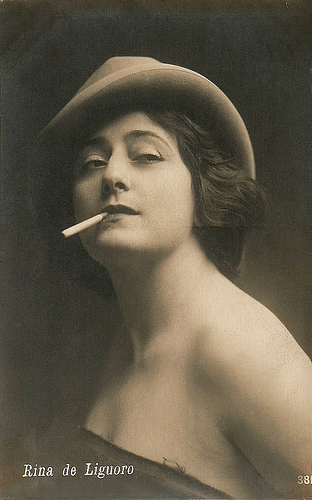
Italian postcard by Ballerini & Fratini, Firenze, no. 381.
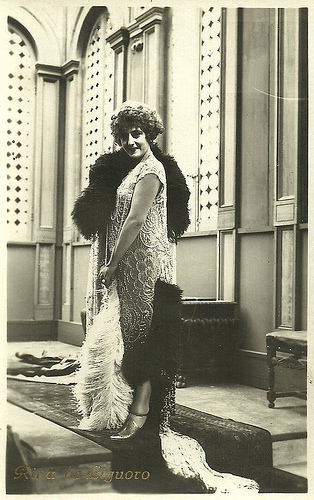
Italian postcard by Ed. G.B. Falci, Milano, no. 475.
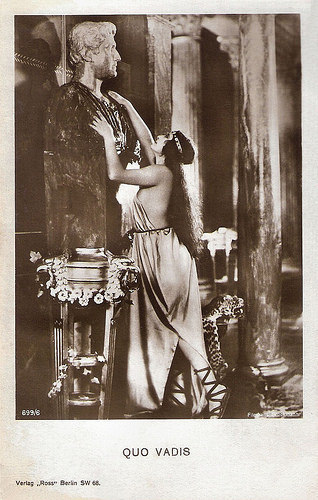
German postcard by Ross-Verlag, Berlin, no. 699/6,1919-1924. Photo: Filmhaus Brückmann. Publicity still for Quo Vadis? (Gabriellino D'Annunzio, Georg Jacoby, 1924).
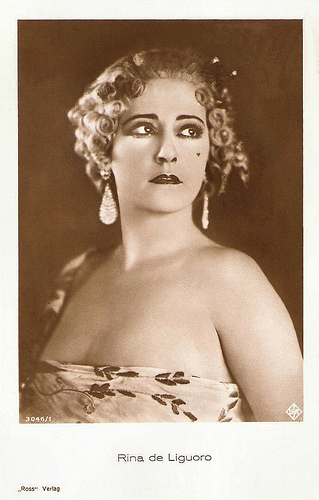
German postcard by Ross Verlag, no. 3046/1, 1928-1929. Photo: Ufa.
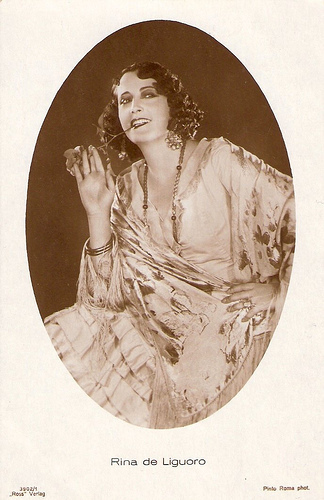
German postcard by Ross Verlag, no. 3902/1, 1928-1929. Photo: Pinto Roma.
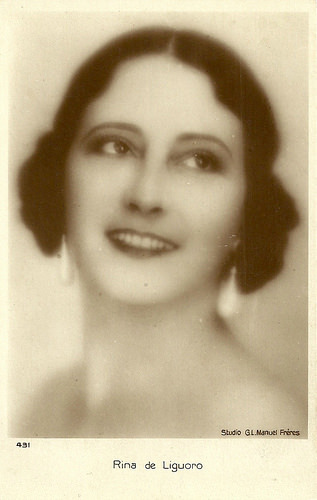
French postcard by Editions Cinémagazine, no. 431. Photo: Studio G.L. Manuel Frères.
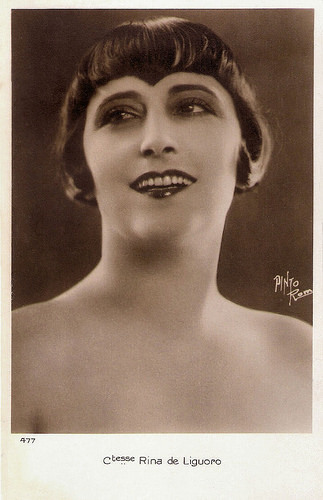
French postcard by Cinémagazine-Edition, Paris, no. 477. Photo: Pinto, Roma. The card refers to her status as countess.
Messalina
Rina De Liguoro was born as Elisabetta Caterina Catardi in Firenze (Florence), Italy, in 1892.
She studied piano with Maestro Luigi Finizio, graduating at the Conservatory of San Pietro a Majella in Naples. She made her debut as a pianist at the age of twenty-five and soon became a valued concert performer.
In 1918, she married count Wladimiro De Liguoro, son of film director and producer Giuseppe De Liguoro. They had a daughter, Regana, born the following year. Later, Wladimiro De Liguoro would direct several of her films.
After a concert in 1920, Rina was invited to visit a film set. During this visit, she appeared as an extra in La Principessa Bebé/The Princess Baby (Lucio D'Ambra, 1920). This was the start of a prolific film career.
She had her breakthrough with the lead role in the historical epic Messalina/The Fall of an Empress (Enrico Guazzoni, 1924), in which she played the sensual, untamed third wife of the Roman Emperor Claudius.
De Liguoro became the last diva of the Italian silent cinema with notable films like Quo vadis? (Gabriellino D'Annunzio, Georg Jacoby, 1924) also starring Emil Jannings , Elena Sangro and Lillian Hall-Davis , and Gli ultimi giorni di Pompeii/The Last Days of Pompeii (Carmine Gallone, Amleto Palermi, 1926) with Victor Varconi and Maria Corda .
There were several attempts in early Fascist Italy to recapture the success of the historical epics of the previous decade. Quo vadis? was produced by the ambitious Unione Cinematografica Italiana. D'Annunzio, the son of the poet Gabriele D'Annunzio, was considered a rising director and also wrote the film's screenplay.
The production ran seriously over-budget, and additional financing had to be raised from Germany. The film was a critical and commercial failure on its release, effectively ending the career of its producer Arturo Ambrosio who had been one of the major figures of early Italian cinema
In the late 1920s, De Liguoro performed in Germany, Austria and France. A masterpiece was the French historical drama Casanova (Alexandre Volkoff, 1927). The film portrays the life and adventures of Giacomo Casanova (1725-1798). Star was the legendary Russian actor Ivan Mozzhukhin . Among the cast and the crew of the film were several Russian émigrés who had come to France following the Russian Revolution.
She also appeared in the French-German silent film drama Cagliostro (Richard Oswald, 1929). It depicts the life of the eighteenth century Italian occultist Alessandro Cagliostro ( Hans Stüwe ), based on a novel by Johannes von Gunther. The film survives but is incomplete.
Her last silent Italian film was Assunta Spina (Roberto Roberti, 1930), a remake of the classic version of 1915, starring Francesca Bertini .
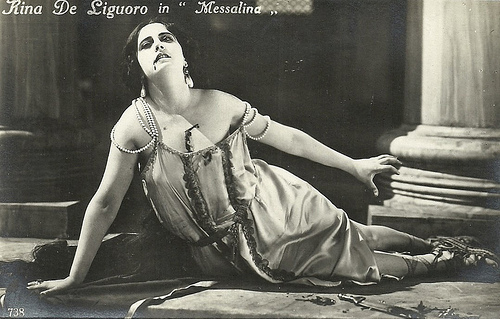
Italian postcard by Ed. A. Traldi, Milano, no. 738. Photo: Rina De Liguoro dying in the final scene of Messalina (Enrico Guazzoni, 1924).
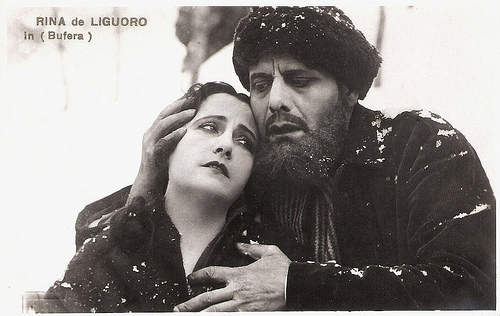
Italian postcard by G.B. Falci Editore, Milano, no. 393. Photo: publicity still for Bufera/Storm (Wladimiro De Liguoro, 1926).
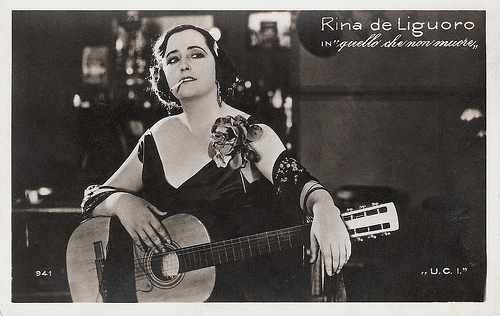
Italian postcard by G. Vettori, Bologna, no. 941. Photo: U.C.I. Publicity still for Quello che non muore/What does not die (Wladimiro De Liguoro, 1926).
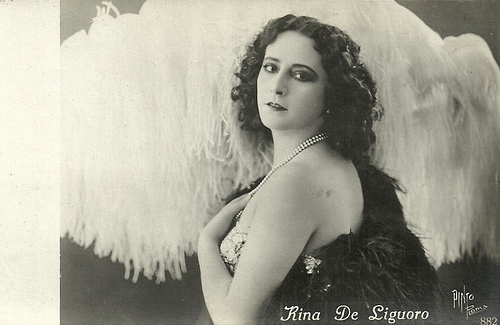
Italian postcard by Ed. A. Traldi, Milano, no. 882. Photo: Pinto, Roma.
Laurel & Hardy
In 1930, Rina De Liguoro was invited to go to Hollywood. As Countess De Liguoro, she appeared in films like the box office success Romance (Clarence Brown, 1930) starring Greta Garbo and the flop Madam Satan (Cecil B. de Mille, 1930).
Wikipedia about the latter: "Madam Satan has been called one of the oddest films DeMille made and certainly one of the oddest MGM made during its 'golden age.' The film originally featured Technicolor sequences that are now lost."
De Liguoro also acted in Spanish-language versions of American films, including Politiquerías (James W. Horne, 1931), the alternate language version of the Laurel & Hardy comedy Chickens Come Home (1931) in which she replaced Mae Busch.
But the silent cinema days were over and Rina De Liguoro could play only minor parts in Hollywood. She decided to try again a career as a piano player.
She returned to Italy in 1939. There she appeared in a few films, including Ritrovarsi/Lost and Found (Oreste Palella, 1947) and Buffalo Bill a Roma/Buffalo Bill in Rome (Giuseppe Accatino, 1949).
Her last role was that of Princess of Presicce, Burt Lancaster's table companion at the ball in Il Gattopardo/The Leopard (Luchino Visconti, 1963).
Rina De Liguoro died in 1966 in Rome, Italy. She had demanded to be buried in her costume for Messalina.
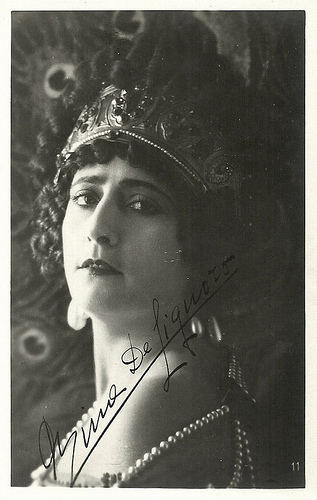
Italian postcard by B&G, B, no. 11. Signed Rina De Liguoro. Photo: Rina De Liguoro as the title character in the epic film Messalina (Enrico Guazzoni, 1924).
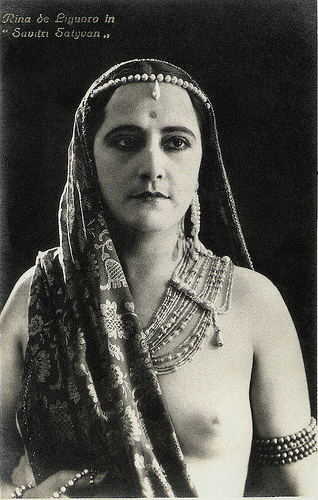
Italian postcard (reproduction). Photo: publicity still for Savitri Satyavan (Giorgio Mannini, 1925), according to Wikipedia 'India's first international co-production', with De Liguoro as the goddess Savitri.
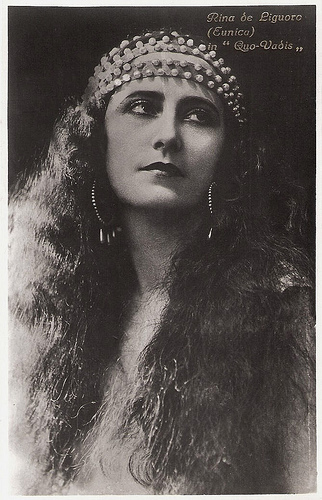
Italian postcard by G.B. Falci, Milano. Photo: still for Quo vadis? (1924).
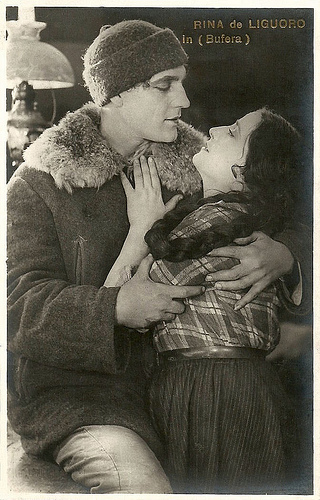
Italian postcard by Ed. G.B. Falci, Milano, no. 388. Photo: Rina De Liguoro and Celio Bucchi in the film Bufera/Storm (Wladimiro De Liguoro, 1926). Bufera is a mountain drama about a woman seduced and abandoned by a rude mountain man, leaving her with a child. When finally her life seems to retake thanks to another, kinder man, the first one reappears. Luckily a mountain storm (hence the title of the film) will swallow the inconvenient intruder.
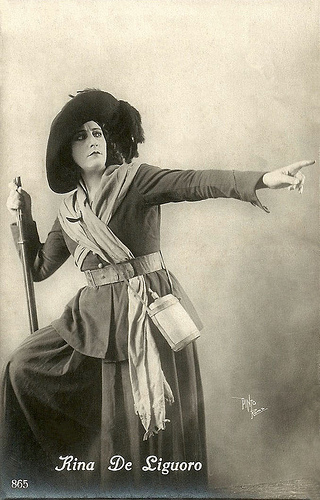
Italian postcard by Ed. A. Traldi, Milano, no. 865. Photo: Pinto, Roma. Rina De Liguoro as Anita Garibaldi in Anita/Il romanzo d'amore dell'eroe dei due mondi (Aldo De Benedetti, 1926).
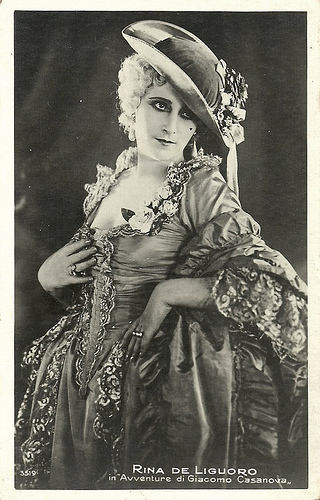
Italian postcard, no. 3519. Photo: Rina De Liguoro as Corticelli in Casanova (Alexandre Volkoff, 1927).
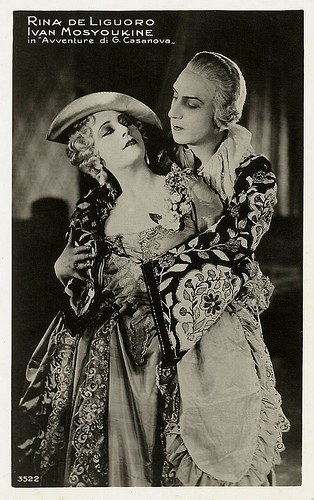
Italian postcard by Ed. Vettori, Bologna, no. 3522. Photo: Rina De Liguoro and Ivan Mozzhukhin in the film Casanova (Alexandre Volkoff, 1927).
Sources: Vittorio Martinelli (Le dive del silenzio - Italian), Hans J. Wollstein (AllMovie), Cristiano Ruggero (Find A Grave), Thomas Staedeli (Cyranos), Wikipedia and .

Italian postcard by Ballerini & Fratini, Firenze, no. 381.

Italian postcard by Ed. G.B. Falci, Milano, no. 475.

German postcard by Ross-Verlag, Berlin, no. 699/6,1919-1924. Photo: Filmhaus Brückmann. Publicity still for Quo Vadis? (Gabriellino D'Annunzio, Georg Jacoby, 1924).

German postcard by Ross Verlag, no. 3046/1, 1928-1929. Photo: Ufa.

German postcard by Ross Verlag, no. 3902/1, 1928-1929. Photo: Pinto Roma.

French postcard by Editions Cinémagazine, no. 431. Photo: Studio G.L. Manuel Frères.

French postcard by Cinémagazine-Edition, Paris, no. 477. Photo: Pinto, Roma. The card refers to her status as countess.
Messalina
Rina De Liguoro was born as Elisabetta Caterina Catardi in Firenze (Florence), Italy, in 1892.
She studied piano with Maestro Luigi Finizio, graduating at the Conservatory of San Pietro a Majella in Naples. She made her debut as a pianist at the age of twenty-five and soon became a valued concert performer.
In 1918, she married count Wladimiro De Liguoro, son of film director and producer Giuseppe De Liguoro. They had a daughter, Regana, born the following year. Later, Wladimiro De Liguoro would direct several of her films.
After a concert in 1920, Rina was invited to visit a film set. During this visit, she appeared as an extra in La Principessa Bebé/The Princess Baby (Lucio D'Ambra, 1920). This was the start of a prolific film career.
She had her breakthrough with the lead role in the historical epic Messalina/The Fall of an Empress (Enrico Guazzoni, 1924), in which she played the sensual, untamed third wife of the Roman Emperor Claudius.
De Liguoro became the last diva of the Italian silent cinema with notable films like Quo vadis? (Gabriellino D'Annunzio, Georg Jacoby, 1924) also starring Emil Jannings , Elena Sangro and Lillian Hall-Davis , and Gli ultimi giorni di Pompeii/The Last Days of Pompeii (Carmine Gallone, Amleto Palermi, 1926) with Victor Varconi and Maria Corda .
There were several attempts in early Fascist Italy to recapture the success of the historical epics of the previous decade. Quo vadis? was produced by the ambitious Unione Cinematografica Italiana. D'Annunzio, the son of the poet Gabriele D'Annunzio, was considered a rising director and also wrote the film's screenplay.
The production ran seriously over-budget, and additional financing had to be raised from Germany. The film was a critical and commercial failure on its release, effectively ending the career of its producer Arturo Ambrosio who had been one of the major figures of early Italian cinema
In the late 1920s, De Liguoro performed in Germany, Austria and France. A masterpiece was the French historical drama Casanova (Alexandre Volkoff, 1927). The film portrays the life and adventures of Giacomo Casanova (1725-1798). Star was the legendary Russian actor Ivan Mozzhukhin . Among the cast and the crew of the film were several Russian émigrés who had come to France following the Russian Revolution.
She also appeared in the French-German silent film drama Cagliostro (Richard Oswald, 1929). It depicts the life of the eighteenth century Italian occultist Alessandro Cagliostro ( Hans Stüwe ), based on a novel by Johannes von Gunther. The film survives but is incomplete.
Her last silent Italian film was Assunta Spina (Roberto Roberti, 1930), a remake of the classic version of 1915, starring Francesca Bertini .

Italian postcard by Ed. A. Traldi, Milano, no. 738. Photo: Rina De Liguoro dying in the final scene of Messalina (Enrico Guazzoni, 1924).

Italian postcard by G.B. Falci Editore, Milano, no. 393. Photo: publicity still for Bufera/Storm (Wladimiro De Liguoro, 1926).

Italian postcard by G. Vettori, Bologna, no. 941. Photo: U.C.I. Publicity still for Quello che non muore/What does not die (Wladimiro De Liguoro, 1926).

Italian postcard by Ed. A. Traldi, Milano, no. 882. Photo: Pinto, Roma.
Laurel & Hardy
In 1930, Rina De Liguoro was invited to go to Hollywood. As Countess De Liguoro, she appeared in films like the box office success Romance (Clarence Brown, 1930) starring Greta Garbo and the flop Madam Satan (Cecil B. de Mille, 1930).
Wikipedia about the latter: "Madam Satan has been called one of the oddest films DeMille made and certainly one of the oddest MGM made during its 'golden age.' The film originally featured Technicolor sequences that are now lost."
De Liguoro also acted in Spanish-language versions of American films, including Politiquerías (James W. Horne, 1931), the alternate language version of the Laurel & Hardy comedy Chickens Come Home (1931) in which she replaced Mae Busch.
But the silent cinema days were over and Rina De Liguoro could play only minor parts in Hollywood. She decided to try again a career as a piano player.
She returned to Italy in 1939. There she appeared in a few films, including Ritrovarsi/Lost and Found (Oreste Palella, 1947) and Buffalo Bill a Roma/Buffalo Bill in Rome (Giuseppe Accatino, 1949).
Her last role was that of Princess of Presicce, Burt Lancaster's table companion at the ball in Il Gattopardo/The Leopard (Luchino Visconti, 1963).
Rina De Liguoro died in 1966 in Rome, Italy. She had demanded to be buried in her costume for Messalina.

Italian postcard by B&G, B, no. 11. Signed Rina De Liguoro. Photo: Rina De Liguoro as the title character in the epic film Messalina (Enrico Guazzoni, 1924).

Italian postcard (reproduction). Photo: publicity still for Savitri Satyavan (Giorgio Mannini, 1925), according to Wikipedia 'India's first international co-production', with De Liguoro as the goddess Savitri.

Italian postcard by G.B. Falci, Milano. Photo: still for Quo vadis? (1924).

Italian postcard by Ed. G.B. Falci, Milano, no. 388. Photo: Rina De Liguoro and Celio Bucchi in the film Bufera/Storm (Wladimiro De Liguoro, 1926). Bufera is a mountain drama about a woman seduced and abandoned by a rude mountain man, leaving her with a child. When finally her life seems to retake thanks to another, kinder man, the first one reappears. Luckily a mountain storm (hence the title of the film) will swallow the inconvenient intruder.

Italian postcard by Ed. A. Traldi, Milano, no. 865. Photo: Pinto, Roma. Rina De Liguoro as Anita Garibaldi in Anita/Il romanzo d'amore dell'eroe dei due mondi (Aldo De Benedetti, 1926).

Italian postcard, no. 3519. Photo: Rina De Liguoro as Corticelli in Casanova (Alexandre Volkoff, 1927).

Italian postcard by Ed. Vettori, Bologna, no. 3522. Photo: Rina De Liguoro and Ivan Mozzhukhin in the film Casanova (Alexandre Volkoff, 1927).
Sources: Vittorio Martinelli (Le dive del silenzio - Italian), Hans J. Wollstein (AllMovie), Cristiano Ruggero (Find A Grave), Thomas Staedeli (Cyranos), Wikipedia and .
Published on January 10, 2015 22:00
January 9, 2015
La course à l'amour (1924)
Today's film special is about a little known French silent film, La course à l'amour/Love on the Run (Paul Barlatier, Charles Keppens, 1924). Les Cinématographes Méric produced a series of postcards for this comedy, which starred Édouard Mathé and Gina Relly. However, the most remarkable person on the postcards is the Italian strongman Mario Guaita-Ausonia.
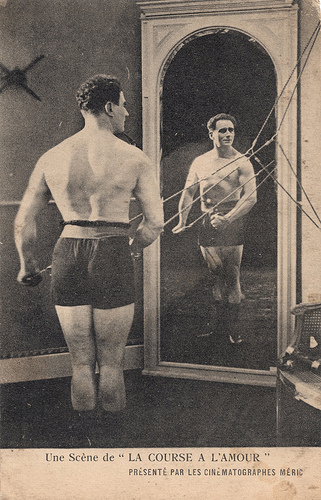
French postcard by Les Cinématographes Méric. Photo: publicity still of Ausonia (Mario Guaita) in the French silent film La course à l'amour/Love on the Run (Paul Barlatier, Charles Keppens, 1924).
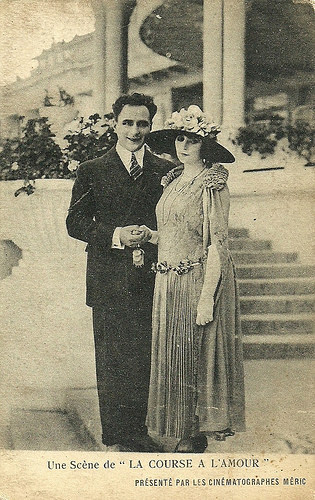
French postcard by Les Cinématographes Méric. Photo: publicity still of the French silent film La course à l'amour (Paul Barlatier, Charles Keppens, 1924).
Sympathetic comedy
La course à l'amour (Paul Barlatier, Charles Keppens, 1924) was a silent black and white production by Lauréa Films, a regional film production company that produced several local films in a studio of the Red Cross since 1920.
Head of productions of Lauréa Film was Paul Barlatier, who was one of the directors and script-writer of this film. His co-director was former actor Charles Keppens.
La Course à l'amour was not the first film made with this title. Wikipedia mentions that in 1912 there had been an early short silent version, La Course à l'amour (Jean Durand, 1912) with comic Onésime and Gaston Modot . It probably had a different script.
In the second version, the lead role was played by Édouard Mathé , the star of the successful serials Les vampires/The Vampires (Louis Feuillade, 1915) and Judex (Louis Feuillade, 1916).
The film was shot on location between Nice and Évian, and the Dictionnaire du cinéma français des années vingt describes it as a 'sympathetic comedy'.
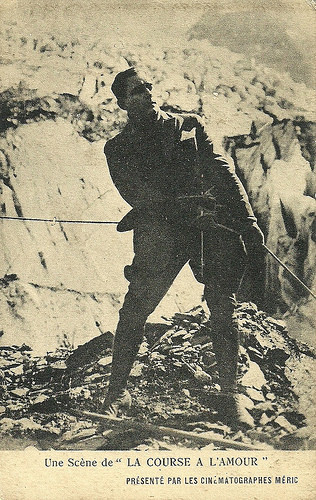
French postcard by Les Cinématographes Méric. Photo: publicity still of La course à l'amour (Paul Barlatier, Charles Keppens, 1924).
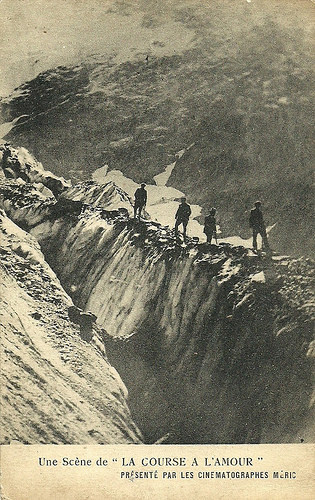
French postcard by Les Cinématographes Méric. Photo: publicity still of La course à l'amour (Paul Barlatier, Charles Keppens, 1924).
Muscleman
A supporting part was played by the athletic muscleman Mario Guaita aka Ausonia. he got the most attention on the postcards made for La course à l'amour.
The Italian had had his international breakthrough with Spartaco/Spartacus (Enrico Vidal, 1913) and in the following decade he became a major actor in the Italian forzuto (strong men) genre.
This genre started with the popular strong man Maciste ( Bartolomeo Pagano ) in the classic spectacle Cabiria (Giovanni Pastrone, 1914). The forzuto can be seen as a forerunner of the Peplum genre of the 1950s and 1960s and Hollywood's superhero films of later decades.
In the early 1920s, Ausonia moved to Marseille, where he made La course à l'amour (1924) and a few other films and where he ran a cinema.
Little is known about La course à l'amour (1924). Despite the series of postcards and Ausonia's impressive muscles, the film was probably not a success. It was the final film for co-director Charles Keppens and for lead actor Édouard Mathé . Also for his co-star Gina Relly , it was one of her last films. Her impressive film career ended two years later.
Lauréa Film ceased its activities and of Paul Barlatier was not heard again.
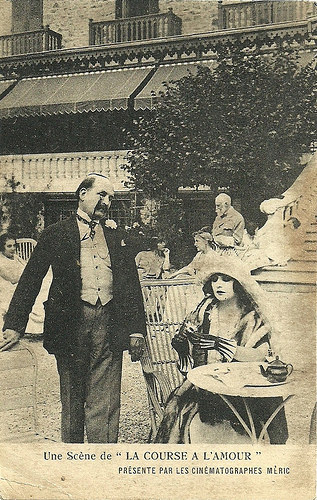
French postcard by Les Cinématographes Méric. Photo: publicity still for La course à l'amour (Paul Barlatier, Charles Keppens, 1924).
Sources: Dictionnaire du cinéma français des années vingt (French) Wikipedia (French) and IMDb.

French postcard by Les Cinématographes Méric. Photo: publicity still of Ausonia (Mario Guaita) in the French silent film La course à l'amour/Love on the Run (Paul Barlatier, Charles Keppens, 1924).

French postcard by Les Cinématographes Méric. Photo: publicity still of the French silent film La course à l'amour (Paul Barlatier, Charles Keppens, 1924).
Sympathetic comedy
La course à l'amour (Paul Barlatier, Charles Keppens, 1924) was a silent black and white production by Lauréa Films, a regional film production company that produced several local films in a studio of the Red Cross since 1920.
Head of productions of Lauréa Film was Paul Barlatier, who was one of the directors and script-writer of this film. His co-director was former actor Charles Keppens.
La Course à l'amour was not the first film made with this title. Wikipedia mentions that in 1912 there had been an early short silent version, La Course à l'amour (Jean Durand, 1912) with comic Onésime and Gaston Modot . It probably had a different script.
In the second version, the lead role was played by Édouard Mathé , the star of the successful serials Les vampires/The Vampires (Louis Feuillade, 1915) and Judex (Louis Feuillade, 1916).
The film was shot on location between Nice and Évian, and the Dictionnaire du cinéma français des années vingt describes it as a 'sympathetic comedy'.

French postcard by Les Cinématographes Méric. Photo: publicity still of La course à l'amour (Paul Barlatier, Charles Keppens, 1924).

French postcard by Les Cinématographes Méric. Photo: publicity still of La course à l'amour (Paul Barlatier, Charles Keppens, 1924).
Muscleman
A supporting part was played by the athletic muscleman Mario Guaita aka Ausonia. he got the most attention on the postcards made for La course à l'amour.
The Italian had had his international breakthrough with Spartaco/Spartacus (Enrico Vidal, 1913) and in the following decade he became a major actor in the Italian forzuto (strong men) genre.
This genre started with the popular strong man Maciste ( Bartolomeo Pagano ) in the classic spectacle Cabiria (Giovanni Pastrone, 1914). The forzuto can be seen as a forerunner of the Peplum genre of the 1950s and 1960s and Hollywood's superhero films of later decades.
In the early 1920s, Ausonia moved to Marseille, where he made La course à l'amour (1924) and a few other films and where he ran a cinema.
Little is known about La course à l'amour (1924). Despite the series of postcards and Ausonia's impressive muscles, the film was probably not a success. It was the final film for co-director Charles Keppens and for lead actor Édouard Mathé . Also for his co-star Gina Relly , it was one of her last films. Her impressive film career ended two years later.
Lauréa Film ceased its activities and of Paul Barlatier was not heard again.

French postcard by Les Cinématographes Méric. Photo: publicity still for La course à l'amour (Paul Barlatier, Charles Keppens, 1924).
Sources: Dictionnaire du cinéma français des années vingt (French) Wikipedia (French) and IMDb.
Published on January 09, 2015 22:00
January 8, 2015
Antonio Banderas
Charismatic Spanish film actor, film director, film producer and singer Antonio Banderas (1960) began his acting career at age 19 with a series of films by director Pedro Almodóvar. He became an internationally known Latin heartthrob with high-profile Hollywood films including Philadelphia (1993), Interview with the Vampire (1994), Desperado (1995), Evita (1996), The Mask of Zorro (1998), and the Shrek sequels. In 2011, the Spanish psychological thriller La piel que habito/The Skin I Live In marked the return of Banderas to Pedro Almodóvar. In their first collaboration in 21 years, Banderas gave one of his best performances ever.
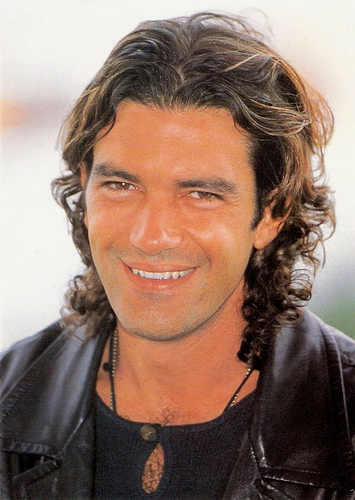
British postcard by Heroes Publishing Ltd, London, no. SPC 2753.
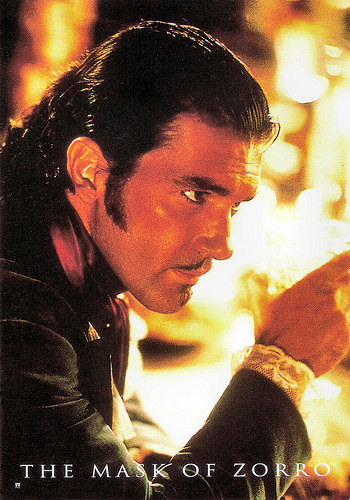
French postcard by Sonis, no. C. 899. Photo: Zorro Productions / Tristar Pictures. Publicity still for The Mask of Zorro (Martin Campbell, 1998).
Innovative and sexually provocative films
José Antonio Domínguez Banderas was born in Málaga, Spain, in 1960. He was the son of Ana Banderas, a school teacher, and José Domínguez, a police officer in the Guardia Civil. He has one younger brother, Francisco. He took his mother's surname as his stage name.
He initially wanted to be a soccer player, but his dream ended when he broke his foot at age 14. At that time he developed a passion for theatre after seeing the stage production of Hair. Banderas began his acting studies at the School of Dramatic Art in Málaga, and made his acting debut at a small theatre in Málaga.
He was arrested by the Spanish police for his performance in a play by Bertolt Brecht, because of the political censorship under the rule of General Francisco Franco. Banderas spent a whole night at the police station. He had three or four of such arrests while he was working with a small theatre troupe that toured all over Spain and was giving performances in small town theatres and on the street.
In 1981, at the age of 19, he moved to Madrid in pursuit of an acting career. There he joined the troupe at the National Theatre of Spain, becoming the youngest member of the company. Banderas' stage performances caught the attention of film director Pedro Almodóvar, who cast the young actor in Pestañas postizas (Enrique Belloch, 1982), produced by Almodóvar.
Banderas and Almodovar joined forces in making innovative and sexually provocative films during the 1980s. He played a gay Islamic terrorist in Laberinto de pasiones/Labyrinth of Passion (Pedro Almodóvar, 1982). In Matador (Pedro Almodóvar, 1986) he played a troubled young man who is confused about his sexuality. Banderas made headlines in Spain with his performance as a psychotic gay stalker, making his first male-to-male on-screen kiss in Almodovar's La ley del deseo/Law of Desire (1987, Pedro Almodóvar) with Carmen Maura.
Banderas's long and fruitful collaboration with Almodóvar eventually prepared him for international recognition that came with his work in the Academy Award-nominated film Mujeres al borde de un ataque de nervios/Women on the Verge of a Nervous Breakdown (Pedro Almodóvar, 1988). He had his breakthrough with the controversial ¡Átame!/Tie Me Up! Tie Me Down! (Pedro Almodóvar, 1989) as mental patient Ricky who kidnaps a porn star (Victoria Abril) and keeps her tied up until she returns his love.
Other Spanish films in which he appeared were El señor Galíndez (Rodolfo Kuhn, 1984) starring Héctor Alterio, Los zancos/The Stilts (Carlos Saura, 1984) with Laura del Sol and Fernando Fernán Gómez, Si te dicen que caí/If They Tell You I Fell (Vicente Aranda, 1989) with Victoria Abril, and Terra Nova (Calogero Salvo, 1991).
In 1991 he got also international attention as an unwitting object of Madonna's affection in the documentary Madonna: Truth or Dare (Alek Keshishian, Mark Aldo Miceli, 1991).
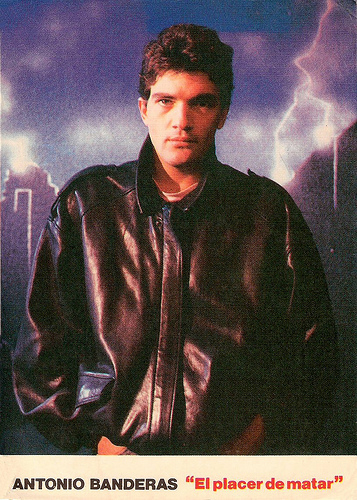
Spanish postcard by Novo Graf for Lauren Films. Photo: publicity still for El placer de matar (Félix Rotaeta, 1988).

Italian postcard by Edibas, no. 582. Photo: Olympia.
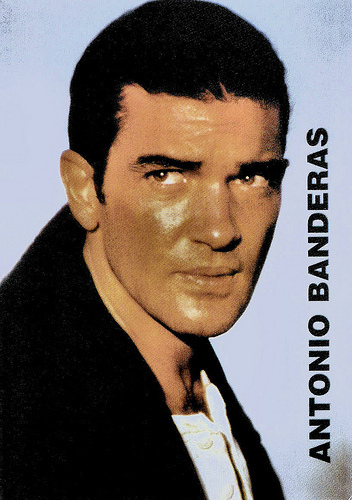
British postcard by Underground, no. BO 115.
A shimmering gunslinger
In 1992 Antonio Banderas made his Hollywood debut with The Mambo Kings (Arne Glimcher, 1992) as a soulful Cuban trumpeter opposite Armand Assante. Because he did not speak English at that time, his dialogue for the film was taught to him phonetically. At AllMovie , Rebecca Flint Marx writes: “Banderas still managed to turn in a critically praised performance as a struggling musician.”
He then shot to international fame with his sensitive performance as the lover of Tom Hanks' AIDS-infected lawyer in Philadelphia (Jonathan Demme, 1993).
During the following years he appeared in several major Hollywood releases. He played a substantial role as a sexy European vampire opposite Tom Cruise and Brad Pitt in the film adaptation of Anne Rice’s Interview with the Vampire: The Vampire Chronicles (Neil Jordan, 1994).
Banderas had a box office hit with his starring role as the shimmering gunslinger El Mariachi in Desperado (Roberto Rodriguez, 1995). He starred as ubiquitous narrator Che alongside Madonna as Eva Peron in Evita (Alan Parker, 1996), an adaptation of the musical by Andrew Lloyd Webber and Tim Rice.
He had another box office success with his role as the legendary masked swordsman Zorro in The Mask of Zorro (1998, Martin Campbell), opposite Anthony Hopkins and Catherina Zeta-Jones. Banderas was the first Latino to play the Mexican swashbuckler.
Banderas' debut as a director was the interesting black comedy Crazy in Alabama (1999), starring his wife Melanie Griffith. In 2000, Ridley Scott offered Banderas a part as a peasant in his film, Gladiator (Ridley Scott, 2000) and he reluctantly accepted, but demanded $ 50,000 for the role - currently the world record for the highest salary of an extra.
In 2001, he collaborated again with Robert Rodriguez who cast him in the Spy Kids films. He also starred in the poor Original Sin (Michael Cristofer, 2001) with Angelina Jolie. In 2002, he starred in the equally poor Femme Fatale (2002, Brian De Palma) opposite Rebecca Romijn-Stamos and in Frida (2002, Julie Taymor) with Salma Hayek.
He reprised his role as El Mariachi in the last instalment of Robert Rodriguez' Mexico trilogy Once Upon A Time In Mexico (Roberto Rodriguez, 2003) with Johnny Depp and Salma Hayek.
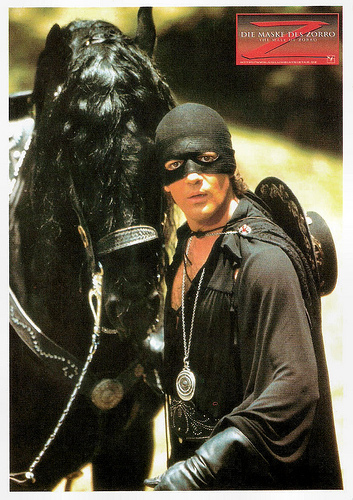
German postcard by Memory Cards, no. 497. Photo: publicity still for The Mask of Zorro (Martin Campbell, 1998).
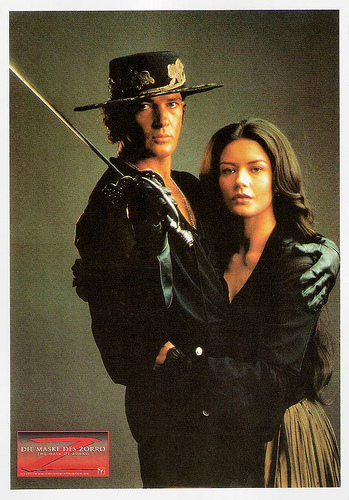
German postcard by Memory Cards, no. 495. Photo: publicity still for The Mask of Zorro (Martin Campbell, 1998), with Catherina Zeta-Jones.
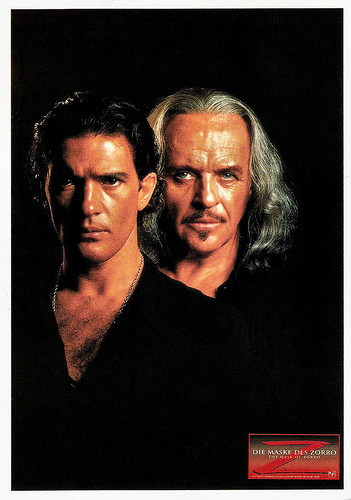
German postcard by Memory Cards, no. 496. Photo: publicity still for The Mask of Zorro (Martin Campbell, 1998), with Anthony Hopkins.
A sexy, macho swashbuckler
In 2003, Antonio Banderas returned to the musical genre, appearing to great acclaim in the Broadway revival of Maury Yeston's musical Nine, based on the film 8½, playing the prime role originated by the late Raúl Juliá. Banderas won both the Outer Critics Circle and Drama Desk awards, and was nominated for the Tony Award for best actor in a musical.
Tweaking his image as a sexy, macho swashbuckler, Banderas next provided the pitch-perfect voice of the rapier-wielding Puss-in-Boots for Shrek 2 (Andrew Adamson, Kelly Asbury, Conrad Verno, 2004), Shrek the Third (Chris Miller, Raman Hui, 2007) and the last film in the Shrek franchise, Shrek Forever After (Mike Mitchell, 2010). The character became so popular on the family film circuit, that it became the protagonist of the spin-off film Puss in Boots: The Story of an Ogre Killer (Mike Mitchell, 2011).
In 2005, Banderas reprised his role as Zorro in The Legend of Zorro (Martin Campbell, 2005), though this was not as successful as the original. A year later, he starred in Take the Lead (Liz Friedlander, 2006), a high school-set movie in which he played a ballroom dancing teacher.
In 2010 he starred in the Woody Allen comedy You Will Meet a Tall Dark Stranger (Woody Allen, 2010). It was followed by Spy Kids 4: All the Time in the World (Robert Rodriguez, 2011).
In 2011 Banderas reteamed for the first time in two decades with Pedro Almodóvar in the Hitchcock-inspired La piel que habito/The Skin I Live In. Perry Seibert at AllMovie: "Luckily, Banderas continues to bring out Almodovar's most-outrageous impulses. You won't hear anyone coming out of this movie muttering, 'we've seen that story before.' But in a way, if you've kept up with Almodovar over the last three decades, you really have seen much of this movie before. Sure, the actual plot points are new, but the themes are quintessential Almodovar. His obsession with cross-dressing finds its seemingly natural conclusion in this film, and he continues to show how most men are slaves to their sexual desires, while most women are forever at the mercy of these unstable men."
The next year he appeared as a mysterious international espionage figure in the action thriller Haywire (Steven Soderbergh, 2012). Recently, he appeared in a small role in Rodriguez's Machete Kills (Robert Rodriguez, 2013) and he joined Sylvester Stallone and his merry band of senior action heroes in The Expendables 3 (Patrick Hughes, 2014).
Antonio Banderas divorced his first wife, actress Ana Leza in 1996, and married Melanie Griffith that same year. They had met a year earlier while shooting the romantic comedy Two Much (Fernando Trueba, 1995). Their romance on the set helped the film set box-office records in Spain. In June 2014 Griffith and Banderas announced their separation after a marriage of 18 years. They have a daughter, Stella Banderas (1996).
TCM : "Handsome, charismatic and undeniably talented, Banderas rightfully earned his place as one of cinema's greatest leading men." Antonio Banderas shares time between his two residencies, one in the United States and one in the South of Spain. He has invested his movie earnings in Andalusian products, and owns 50% of a winery in Northern Spain called Anta Banderas which makes red and rose wines.
According to several newspapers his new girlfriend is Dutch investment banker Nicole Kempel.
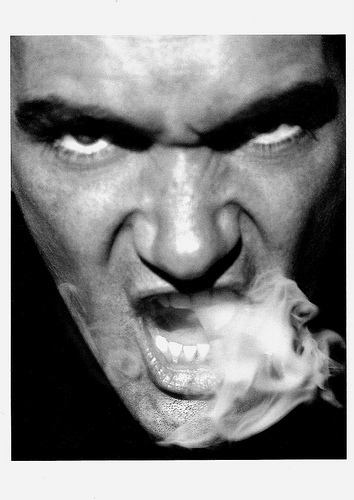
American postcard by Fotofolio. Photo: Herb Ritts, 1994.
Official Trailer ¡Átame!/Tie Me Up! Tie Me Down! (Pedro Almodóvar, 1989). Source: The Cult Box (YouTube).
Official trailer La piel que habito/The Skin I Live In (Pedro Almodóvar, 2011). Source: Streaming Trailers (YouTube).
Sources: Rebecca Flint Marx (AllMovie), (IMDb), Perry Seibert (AllMovie), Lizzie Smith (Daily Mail), TCM, Wikipedia, and .

British postcard by Heroes Publishing Ltd, London, no. SPC 2753.

French postcard by Sonis, no. C. 899. Photo: Zorro Productions / Tristar Pictures. Publicity still for The Mask of Zorro (Martin Campbell, 1998).
Innovative and sexually provocative films
José Antonio Domínguez Banderas was born in Málaga, Spain, in 1960. He was the son of Ana Banderas, a school teacher, and José Domínguez, a police officer in the Guardia Civil. He has one younger brother, Francisco. He took his mother's surname as his stage name.
He initially wanted to be a soccer player, but his dream ended when he broke his foot at age 14. At that time he developed a passion for theatre after seeing the stage production of Hair. Banderas began his acting studies at the School of Dramatic Art in Málaga, and made his acting debut at a small theatre in Málaga.
He was arrested by the Spanish police for his performance in a play by Bertolt Brecht, because of the political censorship under the rule of General Francisco Franco. Banderas spent a whole night at the police station. He had three or four of such arrests while he was working with a small theatre troupe that toured all over Spain and was giving performances in small town theatres and on the street.
In 1981, at the age of 19, he moved to Madrid in pursuit of an acting career. There he joined the troupe at the National Theatre of Spain, becoming the youngest member of the company. Banderas' stage performances caught the attention of film director Pedro Almodóvar, who cast the young actor in Pestañas postizas (Enrique Belloch, 1982), produced by Almodóvar.
Banderas and Almodovar joined forces in making innovative and sexually provocative films during the 1980s. He played a gay Islamic terrorist in Laberinto de pasiones/Labyrinth of Passion (Pedro Almodóvar, 1982). In Matador (Pedro Almodóvar, 1986) he played a troubled young man who is confused about his sexuality. Banderas made headlines in Spain with his performance as a psychotic gay stalker, making his first male-to-male on-screen kiss in Almodovar's La ley del deseo/Law of Desire (1987, Pedro Almodóvar) with Carmen Maura.
Banderas's long and fruitful collaboration with Almodóvar eventually prepared him for international recognition that came with his work in the Academy Award-nominated film Mujeres al borde de un ataque de nervios/Women on the Verge of a Nervous Breakdown (Pedro Almodóvar, 1988). He had his breakthrough with the controversial ¡Átame!/Tie Me Up! Tie Me Down! (Pedro Almodóvar, 1989) as mental patient Ricky who kidnaps a porn star (Victoria Abril) and keeps her tied up until she returns his love.
Other Spanish films in which he appeared were El señor Galíndez (Rodolfo Kuhn, 1984) starring Héctor Alterio, Los zancos/The Stilts (Carlos Saura, 1984) with Laura del Sol and Fernando Fernán Gómez, Si te dicen que caí/If They Tell You I Fell (Vicente Aranda, 1989) with Victoria Abril, and Terra Nova (Calogero Salvo, 1991).
In 1991 he got also international attention as an unwitting object of Madonna's affection in the documentary Madonna: Truth or Dare (Alek Keshishian, Mark Aldo Miceli, 1991).

Spanish postcard by Novo Graf for Lauren Films. Photo: publicity still for El placer de matar (Félix Rotaeta, 1988).

Italian postcard by Edibas, no. 582. Photo: Olympia.

British postcard by Underground, no. BO 115.
A shimmering gunslinger
In 1992 Antonio Banderas made his Hollywood debut with The Mambo Kings (Arne Glimcher, 1992) as a soulful Cuban trumpeter opposite Armand Assante. Because he did not speak English at that time, his dialogue for the film was taught to him phonetically. At AllMovie , Rebecca Flint Marx writes: “Banderas still managed to turn in a critically praised performance as a struggling musician.”
He then shot to international fame with his sensitive performance as the lover of Tom Hanks' AIDS-infected lawyer in Philadelphia (Jonathan Demme, 1993).
During the following years he appeared in several major Hollywood releases. He played a substantial role as a sexy European vampire opposite Tom Cruise and Brad Pitt in the film adaptation of Anne Rice’s Interview with the Vampire: The Vampire Chronicles (Neil Jordan, 1994).
Banderas had a box office hit with his starring role as the shimmering gunslinger El Mariachi in Desperado (Roberto Rodriguez, 1995). He starred as ubiquitous narrator Che alongside Madonna as Eva Peron in Evita (Alan Parker, 1996), an adaptation of the musical by Andrew Lloyd Webber and Tim Rice.
He had another box office success with his role as the legendary masked swordsman Zorro in The Mask of Zorro (1998, Martin Campbell), opposite Anthony Hopkins and Catherina Zeta-Jones. Banderas was the first Latino to play the Mexican swashbuckler.
Banderas' debut as a director was the interesting black comedy Crazy in Alabama (1999), starring his wife Melanie Griffith. In 2000, Ridley Scott offered Banderas a part as a peasant in his film, Gladiator (Ridley Scott, 2000) and he reluctantly accepted, but demanded $ 50,000 for the role - currently the world record for the highest salary of an extra.
In 2001, he collaborated again with Robert Rodriguez who cast him in the Spy Kids films. He also starred in the poor Original Sin (Michael Cristofer, 2001) with Angelina Jolie. In 2002, he starred in the equally poor Femme Fatale (2002, Brian De Palma) opposite Rebecca Romijn-Stamos and in Frida (2002, Julie Taymor) with Salma Hayek.
He reprised his role as El Mariachi in the last instalment of Robert Rodriguez' Mexico trilogy Once Upon A Time In Mexico (Roberto Rodriguez, 2003) with Johnny Depp and Salma Hayek.

German postcard by Memory Cards, no. 497. Photo: publicity still for The Mask of Zorro (Martin Campbell, 1998).

German postcard by Memory Cards, no. 495. Photo: publicity still for The Mask of Zorro (Martin Campbell, 1998), with Catherina Zeta-Jones.

German postcard by Memory Cards, no. 496. Photo: publicity still for The Mask of Zorro (Martin Campbell, 1998), with Anthony Hopkins.
A sexy, macho swashbuckler
In 2003, Antonio Banderas returned to the musical genre, appearing to great acclaim in the Broadway revival of Maury Yeston's musical Nine, based on the film 8½, playing the prime role originated by the late Raúl Juliá. Banderas won both the Outer Critics Circle and Drama Desk awards, and was nominated for the Tony Award for best actor in a musical.
Tweaking his image as a sexy, macho swashbuckler, Banderas next provided the pitch-perfect voice of the rapier-wielding Puss-in-Boots for Shrek 2 (Andrew Adamson, Kelly Asbury, Conrad Verno, 2004), Shrek the Third (Chris Miller, Raman Hui, 2007) and the last film in the Shrek franchise, Shrek Forever After (Mike Mitchell, 2010). The character became so popular on the family film circuit, that it became the protagonist of the spin-off film Puss in Boots: The Story of an Ogre Killer (Mike Mitchell, 2011).
In 2005, Banderas reprised his role as Zorro in The Legend of Zorro (Martin Campbell, 2005), though this was not as successful as the original. A year later, he starred in Take the Lead (Liz Friedlander, 2006), a high school-set movie in which he played a ballroom dancing teacher.
In 2010 he starred in the Woody Allen comedy You Will Meet a Tall Dark Stranger (Woody Allen, 2010). It was followed by Spy Kids 4: All the Time in the World (Robert Rodriguez, 2011).
In 2011 Banderas reteamed for the first time in two decades with Pedro Almodóvar in the Hitchcock-inspired La piel que habito/The Skin I Live In. Perry Seibert at AllMovie: "Luckily, Banderas continues to bring out Almodovar's most-outrageous impulses. You won't hear anyone coming out of this movie muttering, 'we've seen that story before.' But in a way, if you've kept up with Almodovar over the last three decades, you really have seen much of this movie before. Sure, the actual plot points are new, but the themes are quintessential Almodovar. His obsession with cross-dressing finds its seemingly natural conclusion in this film, and he continues to show how most men are slaves to their sexual desires, while most women are forever at the mercy of these unstable men."
The next year he appeared as a mysterious international espionage figure in the action thriller Haywire (Steven Soderbergh, 2012). Recently, he appeared in a small role in Rodriguez's Machete Kills (Robert Rodriguez, 2013) and he joined Sylvester Stallone and his merry band of senior action heroes in The Expendables 3 (Patrick Hughes, 2014).
Antonio Banderas divorced his first wife, actress Ana Leza in 1996, and married Melanie Griffith that same year. They had met a year earlier while shooting the romantic comedy Two Much (Fernando Trueba, 1995). Their romance on the set helped the film set box-office records in Spain. In June 2014 Griffith and Banderas announced their separation after a marriage of 18 years. They have a daughter, Stella Banderas (1996).
TCM : "Handsome, charismatic and undeniably talented, Banderas rightfully earned his place as one of cinema's greatest leading men." Antonio Banderas shares time between his two residencies, one in the United States and one in the South of Spain. He has invested his movie earnings in Andalusian products, and owns 50% of a winery in Northern Spain called Anta Banderas which makes red and rose wines.
According to several newspapers his new girlfriend is Dutch investment banker Nicole Kempel.

American postcard by Fotofolio. Photo: Herb Ritts, 1994.
Official Trailer ¡Átame!/Tie Me Up! Tie Me Down! (Pedro Almodóvar, 1989). Source: The Cult Box (YouTube).
Official trailer La piel que habito/The Skin I Live In (Pedro Almodóvar, 2011). Source: Streaming Trailers (YouTube).
Sources: Rebecca Flint Marx (AllMovie), (IMDb), Perry Seibert (AllMovie), Lizzie Smith (Daily Mail), TCM, Wikipedia, and .
Published on January 08, 2015 22:00
January 7, 2015
Raymond Rouleau
Raymond Rouleau (1904-1981) was a Belgian actor and film director. He appeared in 49 films between 1928 and 1979, and also directed 22 films.
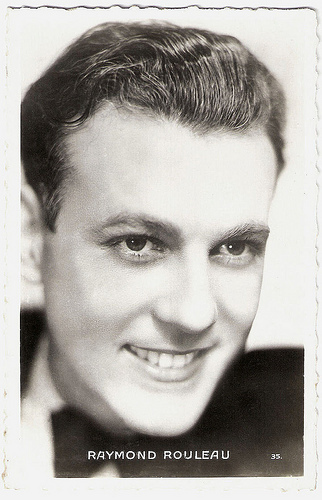
French postcard by Ed. Chantal, Paris, no. 35.
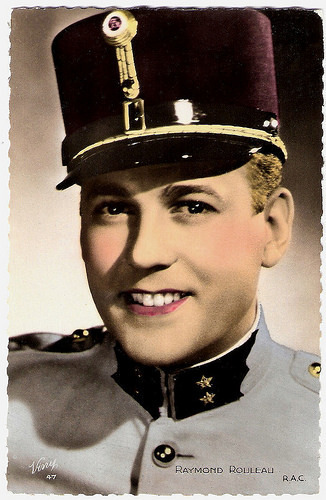
French postcard by Viny, no. 47. Photo: R.A.C.
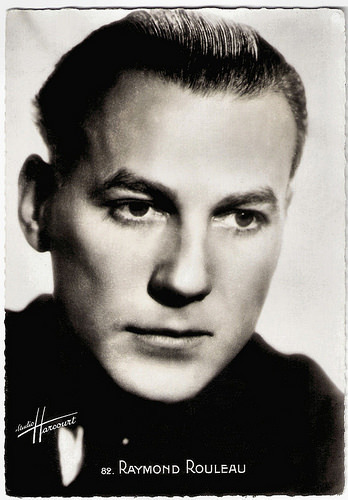
French postcard by S.E.R.P., Paris, no. 77. Photo: Studio Harcourt.
Who Killed Santa Claus?
Raymond Rouleau was born as Edgar Rouleau in Brussels, Belgium in 1904. After studying at the Conservatoire Royal de Bruxelles (the Royal Conservatory of Brussels), he moved to Paris and worked there with Antonin Artaud and Charles Dullin .
In 1928, he turned to the cinema and appeared in the silent classic L'argent/The money (Marcel L’Herbier, 1928) starring Brigitte Helm . James Travers at French Film Guide : “At a cost of nearly five million francs, L'Argent was Marcel L'Herbier's most lavish and greatest film. Based on a novel of the same name by Emile Zola, but updated to contemporary France, the film makes an unveiled condemnation on the world of high finance, particularly the sin of speculation, the thing L'Herbier hated above all else. Thanks to its modern setting and simple story of greed and corruption, the film is just as relevant today as it was in the late 1920s.”
After more small roles, Rouleau played the male lead in La femme nue/The naked woman (Jean-Paul Paulin, 1933) opposite Florelle . He directed the drama Une vie perdue/Journal of a Crime (Raymond Rouleau, 1933). He co-starred with Simone Simon and Jean-Pierre Aumont in the romantic Les beaux jours/Happy days (Marc Allégret, 1935).
In 1937, he starred opposite Louis Jouvet in the French drama Le drame de Shanghaï/The Shanghai Drama (Georg Wilhelm Pabst, 1938), an ambitious mix of film noir, melodrama and reportage set against the backdrop of the Chinese Civil War of the 1930s. He also appeared in the disturbing melodrama Conflit/Conflict (Léonide Moguy, 1938), starring Corinne Luchaire and Annie Ducaux as two sisters.
On 24 May 1940 he volunteered in the army, and was assigned to Sanitary Sections of the front on 30 May. He was a war prisoner in July, August and September 1940. Later he was honoured with the Croix de Guerre and the Medal of Volunteer Workers.
He appeared again in films like the romantic comedy Premier bal/First Ball (Christian-Jaque, 1941) with Marie Déa , and L'assassinat du Père Noël/Who Killed Santa Claus? (Roger Chapatte, Christian-Jaque, 1941) starring Harry Baur. At French Film Guide , James Travers writes: “With its claustrophobic account of a close-knit community being torn apart by fear, suspicion and malicious denunciations, L'Assassinat du Père Noël has much in common with Henri-Georges Clouzot's Le Corbeau (1943). The plots may differ but the two films powerfully evoke the mood of the time in which they were made, conveying the sense of mistrust and paranoia that was widely felt in France during the Occupation.”
In 1942, Rouleau co-founded with Jean-Louis Barrault and Julien Bertheau l'École du Comédien (the School of comedians), which existed till 1944. From 1944 to 1951, he headed the Théâtre de l'Oeuvre with Lucien Beer.
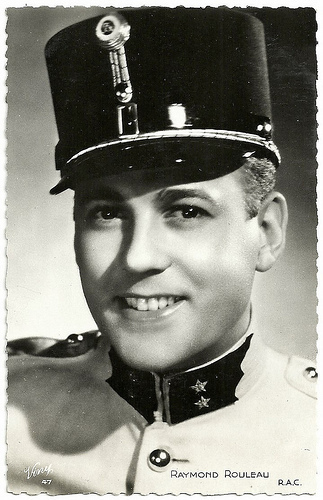
French postcard by Viny, no. 47. Photo: R.A.C.
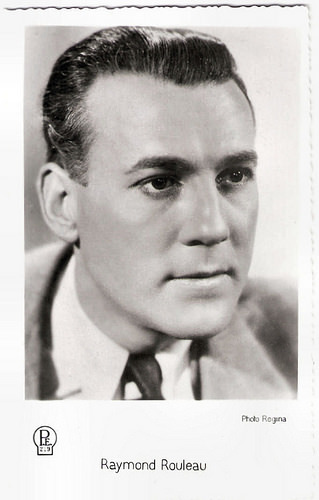
Belgian postcard by P.E. (Photo Edition), Bruxelles, no. 239. Photo: Regina.
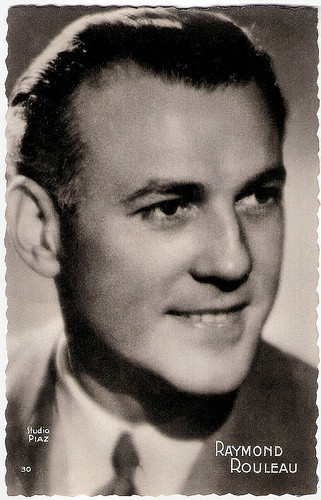
French postcard by Editions O.P., Paris, no. 30. Photo: Studio Piaz.
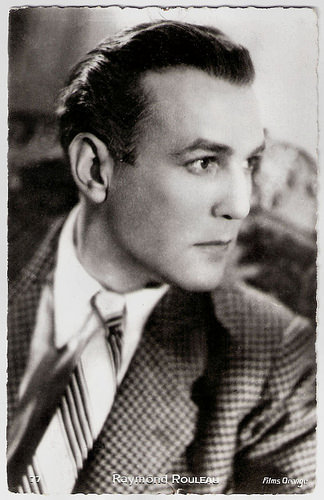
French postcard, no. 77. Photo: Films Orange.
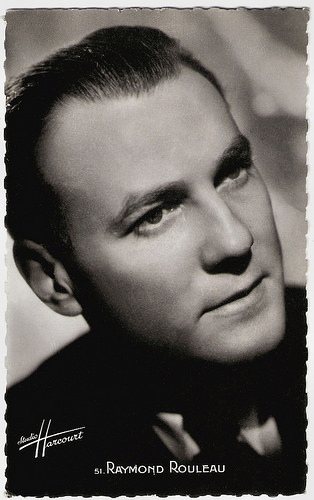
French postcard by S.E.R.P., Paris, no. 51. Photo: Studio Harcourt.
An actor who required
After the war, Raymond Rouleau continued to star in films like Falbalas/Paris Frills (Jacques Becker, 1945) with Micheline Presle , and Dernier refuge/Last Refuge (Marc Maurette, 1947) with Gisèle Pascal and based on Georges Siménon’s Le Locataire.
In 1949, he played reporter Georges Mass in Mission à Tanger/Mission in Tangier (André Hunebelle, 1949), which was the first film scripted by Michel Audiard. He worked again with director André Hunebelle at Méfiez-vous des blondes/Beware of blondes (André Hunebelle, 1950) and Massacre en dentelles/Massacre in lace (André Hunebelle, 1951). According to Michel Audiard, Raymond Rouleau was an actor who 'did not discuss, but who required!'
He starred opposite Jeanne Moreau in the French film noir Les Intrigantes/The Plotters (Henri Decoin, 1954). As a director, he made Les Sorcières de Salem/The Crucible (Raymond Rouleau, 1957) with Simone Signoret , Yves Montand and Mylène Démongeot . The screenplay was adapted by Jean-Paul Sartre from the play The Crucible, by Arthur Miller.
In 1958, he founded the Nouveau Cartel (New Cartel) with André Barsacq, Jean Mercure and Jean-Louis Barrault.
Later he directed the musical Les Amants de Teruel/The Lovers of Teruel (Raymond Rouleau, 1962) with Ludmilla Tchérina , which was entered into the 1962 Cannes Film Festival. Eleanor Mannika at AllMovie : “This puzzling experimental film is written and directed by Raymond Rouleau, who uses effects like changing color tones and masks to put across a drama within a dance drama. The set is a sound stage and the actors in this film are dancers on the stage, performing a mime-ballet derived from one particular legend.”
In 1973, he made Vogue la galère (Raymond Rouleau, 1973) with Claude Dauphin and Robert Hossein . His final film as an actor was the TV-film Le destin de Priscilla Davies/The fate of Priscilla Davies (Raymond Rouleau, 1979), adapted by Rouleau from a short story by Henry James.
In 1981, Raymond Rouleau passed away in Paris, at the age of 77. He was married to the actresses Tania Balachova, Françoise Lugagne and Françoise Cremieux. He is the father of Philippe Rouleau and Fabrice Rouleau, from his marriage to Françoise Lugagne.
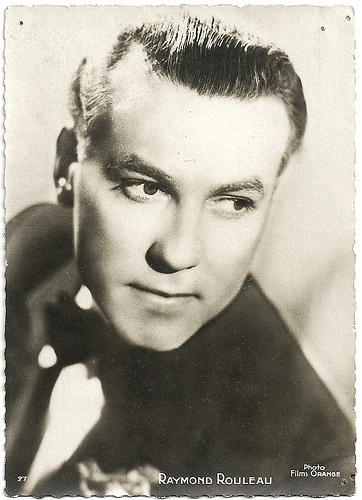
French postcard, no. 27. Photo: Films Orange.
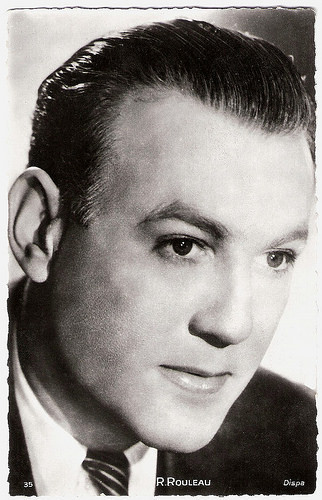
French postcard, no. 35. Photo: Dispa.
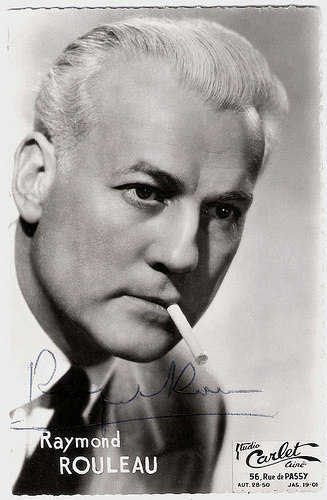
French autograph card. Photo: Studio Carlet Ainé, Paris.
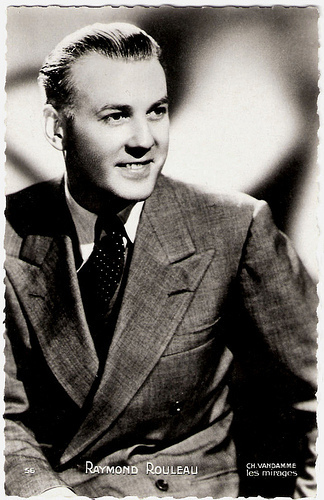
French postcard, no. 57. Photo: Ch. Vandamme / Les Mirages.
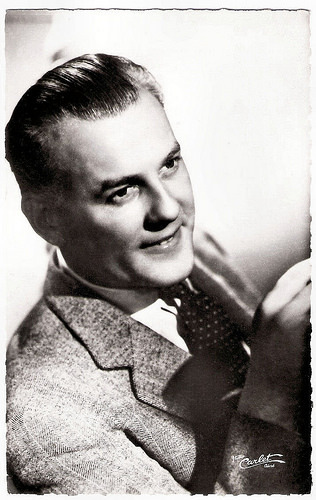
French postcard by Editions du Globe, no. 63. Photo: Carlet, Ainé.
Sources: James Travers (French Films Site), Eleanor Mannikka (AllMovie), Wikipedia (French and English) and .

French postcard by Ed. Chantal, Paris, no. 35.

French postcard by Viny, no. 47. Photo: R.A.C.

French postcard by S.E.R.P., Paris, no. 77. Photo: Studio Harcourt.
Who Killed Santa Claus?
Raymond Rouleau was born as Edgar Rouleau in Brussels, Belgium in 1904. After studying at the Conservatoire Royal de Bruxelles (the Royal Conservatory of Brussels), he moved to Paris and worked there with Antonin Artaud and Charles Dullin .
In 1928, he turned to the cinema and appeared in the silent classic L'argent/The money (Marcel L’Herbier, 1928) starring Brigitte Helm . James Travers at French Film Guide : “At a cost of nearly five million francs, L'Argent was Marcel L'Herbier's most lavish and greatest film. Based on a novel of the same name by Emile Zola, but updated to contemporary France, the film makes an unveiled condemnation on the world of high finance, particularly the sin of speculation, the thing L'Herbier hated above all else. Thanks to its modern setting and simple story of greed and corruption, the film is just as relevant today as it was in the late 1920s.”
After more small roles, Rouleau played the male lead in La femme nue/The naked woman (Jean-Paul Paulin, 1933) opposite Florelle . He directed the drama Une vie perdue/Journal of a Crime (Raymond Rouleau, 1933). He co-starred with Simone Simon and Jean-Pierre Aumont in the romantic Les beaux jours/Happy days (Marc Allégret, 1935).
In 1937, he starred opposite Louis Jouvet in the French drama Le drame de Shanghaï/The Shanghai Drama (Georg Wilhelm Pabst, 1938), an ambitious mix of film noir, melodrama and reportage set against the backdrop of the Chinese Civil War of the 1930s. He also appeared in the disturbing melodrama Conflit/Conflict (Léonide Moguy, 1938), starring Corinne Luchaire and Annie Ducaux as two sisters.
On 24 May 1940 he volunteered in the army, and was assigned to Sanitary Sections of the front on 30 May. He was a war prisoner in July, August and September 1940. Later he was honoured with the Croix de Guerre and the Medal of Volunteer Workers.
He appeared again in films like the romantic comedy Premier bal/First Ball (Christian-Jaque, 1941) with Marie Déa , and L'assassinat du Père Noël/Who Killed Santa Claus? (Roger Chapatte, Christian-Jaque, 1941) starring Harry Baur. At French Film Guide , James Travers writes: “With its claustrophobic account of a close-knit community being torn apart by fear, suspicion and malicious denunciations, L'Assassinat du Père Noël has much in common with Henri-Georges Clouzot's Le Corbeau (1943). The plots may differ but the two films powerfully evoke the mood of the time in which they were made, conveying the sense of mistrust and paranoia that was widely felt in France during the Occupation.”
In 1942, Rouleau co-founded with Jean-Louis Barrault and Julien Bertheau l'École du Comédien (the School of comedians), which existed till 1944. From 1944 to 1951, he headed the Théâtre de l'Oeuvre with Lucien Beer.

French postcard by Viny, no. 47. Photo: R.A.C.

Belgian postcard by P.E. (Photo Edition), Bruxelles, no. 239. Photo: Regina.

French postcard by Editions O.P., Paris, no. 30. Photo: Studio Piaz.

French postcard, no. 77. Photo: Films Orange.

French postcard by S.E.R.P., Paris, no. 51. Photo: Studio Harcourt.
An actor who required
After the war, Raymond Rouleau continued to star in films like Falbalas/Paris Frills (Jacques Becker, 1945) with Micheline Presle , and Dernier refuge/Last Refuge (Marc Maurette, 1947) with Gisèle Pascal and based on Georges Siménon’s Le Locataire.
In 1949, he played reporter Georges Mass in Mission à Tanger/Mission in Tangier (André Hunebelle, 1949), which was the first film scripted by Michel Audiard. He worked again with director André Hunebelle at Méfiez-vous des blondes/Beware of blondes (André Hunebelle, 1950) and Massacre en dentelles/Massacre in lace (André Hunebelle, 1951). According to Michel Audiard, Raymond Rouleau was an actor who 'did not discuss, but who required!'
He starred opposite Jeanne Moreau in the French film noir Les Intrigantes/The Plotters (Henri Decoin, 1954). As a director, he made Les Sorcières de Salem/The Crucible (Raymond Rouleau, 1957) with Simone Signoret , Yves Montand and Mylène Démongeot . The screenplay was adapted by Jean-Paul Sartre from the play The Crucible, by Arthur Miller.
In 1958, he founded the Nouveau Cartel (New Cartel) with André Barsacq, Jean Mercure and Jean-Louis Barrault.
Later he directed the musical Les Amants de Teruel/The Lovers of Teruel (Raymond Rouleau, 1962) with Ludmilla Tchérina , which was entered into the 1962 Cannes Film Festival. Eleanor Mannika at AllMovie : “This puzzling experimental film is written and directed by Raymond Rouleau, who uses effects like changing color tones and masks to put across a drama within a dance drama. The set is a sound stage and the actors in this film are dancers on the stage, performing a mime-ballet derived from one particular legend.”
In 1973, he made Vogue la galère (Raymond Rouleau, 1973) with Claude Dauphin and Robert Hossein . His final film as an actor was the TV-film Le destin de Priscilla Davies/The fate of Priscilla Davies (Raymond Rouleau, 1979), adapted by Rouleau from a short story by Henry James.
In 1981, Raymond Rouleau passed away in Paris, at the age of 77. He was married to the actresses Tania Balachova, Françoise Lugagne and Françoise Cremieux. He is the father of Philippe Rouleau and Fabrice Rouleau, from his marriage to Françoise Lugagne.

French postcard, no. 27. Photo: Films Orange.

French postcard, no. 35. Photo: Dispa.

French autograph card. Photo: Studio Carlet Ainé, Paris.

French postcard, no. 57. Photo: Ch. Vandamme / Les Mirages.

French postcard by Editions du Globe, no. 63. Photo: Carlet, Ainé.
Sources: James Travers (French Films Site), Eleanor Mannikka (AllMovie), Wikipedia (French and English) and .
Published on January 07, 2015 22:00
January 6, 2015
Cornel Lucas
In 2015, we continue the series on film star photographers with ten new posts. We start today with British photographer Cornel Lucas (1920-2012), whose glamorous work for Rank during the 1940s and 1950s was used for several postcards.
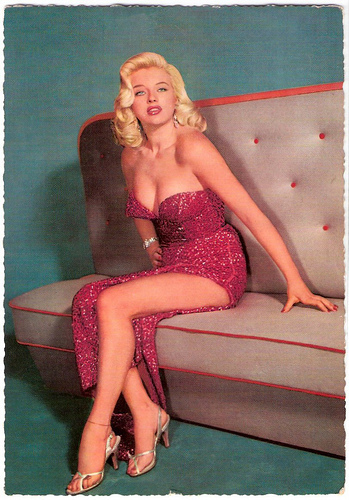
Diana Dors . German postcard by Kruger, no. 902/80. Photo: Ufa / Cornel Lucas, 1952.
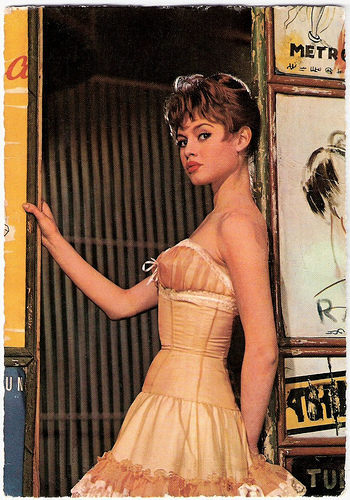
Brigitte Bardot. German postcard by Krüger. Photo: Cornel Lucas, 1955. Publicity still for Doctor at Sea (Ralph Thomas, 1955).
A Mink Bikini
Henry Cornel Lucas was born in Highbury, north London, in 1920. He was one of eight children. His interest in photography was sparked when his mother, Mary Ann, bought him a Kodak Box Brownie snapshot camera for his 11th birthday.
An elder brother ran a film library, and one day he took Cornel to the studios where he was working. At 15, his brother got him a job as a trainee at the same film-processing laboratory he worked at. Cornel also studied Photography part-time at Regent Street Polytechnic (now the University of Westminster). During World War II he helped to develop spy photography systems for the Royal Air Force.
After the war Lucas joined Denham Studios in Buckinghamshire. His big break came in 1948 when he was still a relative newcomer in the publicity department at Denham. He was asked to photograph Marlene Dietrich , who had come to England to make No Highway in the Sky (1951). The star had dismissed the first photographer assigned to her for what she considered incompetent lighting technique.
The session did not start off well. There was little that Dietrich did not know about photographic printing, lighting and composition, and she wasted no time in small talk with the young photographer.
The Telegraph : "Lucas lit her from several angles, picking out the sharp lines of her cheekbones and illuminating the flawless but icy perfection of her face. Her favourite lighting was from above, a difficult technique for photographers." Dietrich was pleased with the results, and Lucas went on to become one of the few portraitists she would work with.
Cornel Lucas became in charge of the photographic studios set up by The Rank Organisation at Pinewood. The studio was known as the 'pool studio', while it was set up on an old swimming pool site. Here, Lucas photographed many film stars in the late forties and fifties including David Niven , Stewart Granger , Jean Simmons , and Brigitte Bardot .
Lucas gave rugged, masculine glamour to Dirk Bogarde and Trevor Howard , and created the star images of the young Joan Collins and Diana Dors . He photographed Dors in a bikini in a gondola in Venice and made a memorable portrait of her wearing a 'mink' bikini of which he later discovered it was actually made of rabbit.
At the height of the studio system, Rank had more than 50 stars under contract and every week thousands of photo prints were sent out around the world.
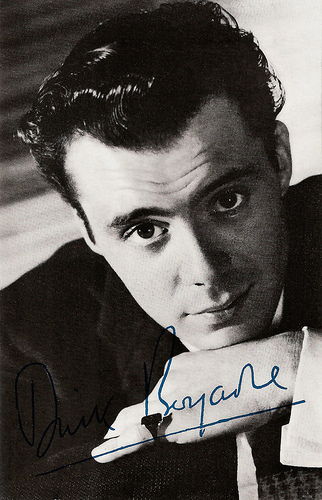
Dirk Bogarde . British postcard in the Film Star Autograph Portrait Series by Celebrity Publishers, London, no. 51. Photo: Cornel Lucas / Rank.

Trevor Howard . Dutch postcard, no. AX 289. Photo: Cornel Lucas / J. Arthur Rank Organisation.

Belinda Lee . German postcard by Kolibri-Verlag G.m.b.H, Minden/Westf., no. 2720. Photo: Cornel Lucas / J. Arthur Rank Organisation.
Rank's most glamorous starlet
Slim, tanned and strikingly handsome, Cornel Lucas became friends with most of the stars he worked with and was remarkably tolerant of their foibles.
In 1955 he married one of Rank’s most glamorous starlets, Belinda Lee . Three years later, however, the marriage broke down after she had an affair with an Italian prince. In 1961 she was killed in a car accident, aged 26.
Lucas left Pinewood in 1959, when the studio system of stars under contract was coming to an end. He set up as a freelance artist and opened his own studio in Flood Street, Chelsea. There he continued to specialise in portraiture, while also embracing wider aspects of photography, particularly high-fashion advertising and television commercials.
Lucas’s work has been shown at major exhibitions in London and New York, and a number of his photos are held in the permanent collections of the National Portrait Gallery, the National Media Museum, London's Photographers' Gallery and the Victoria and Albert Museum.
In 1998, he was the first photographer to win a British Academy of Film and Television Arts (Bafta) award for his services to the British film industry. He published two books of his work, 'Heads and Tales' and 'Shooting Stars'.
Cornel Lucas died in 2012 at the age of 92. Since 1960, he was married to actress Susan Travers. They had three sons, Jonathan, Frederick and Linus, and a daughter, Charlotte.
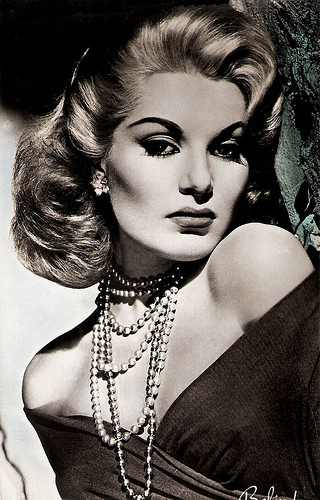
Belinda Lee . Yugoslavian postcard by Izrada Nas Glas, Smederevo, no. 105. Photo: Cornel Lucas.
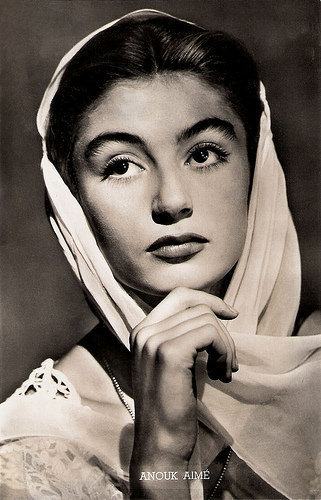
Anouk Aimee . Dutch postcard, no. 453. Photo: Cornel Lucas.
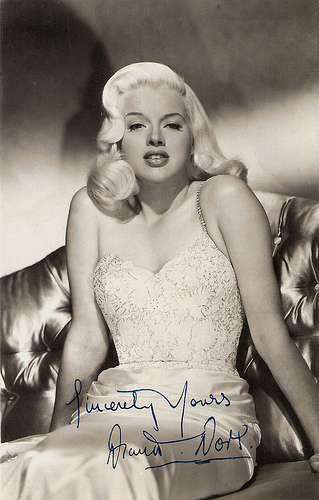
Diana Dors . British autograph card. Photo: Cornel Lucas / Rank.
At the right, you find elder posts under the caption 'The Photographers'.
Sources: (The Independent), Paul Vitello (New York Times), The Telegraph, Cornel Lucas Collection, and Wikipedia.

Diana Dors . German postcard by Kruger, no. 902/80. Photo: Ufa / Cornel Lucas, 1952.

Brigitte Bardot. German postcard by Krüger. Photo: Cornel Lucas, 1955. Publicity still for Doctor at Sea (Ralph Thomas, 1955).
A Mink Bikini
Henry Cornel Lucas was born in Highbury, north London, in 1920. He was one of eight children. His interest in photography was sparked when his mother, Mary Ann, bought him a Kodak Box Brownie snapshot camera for his 11th birthday.
An elder brother ran a film library, and one day he took Cornel to the studios where he was working. At 15, his brother got him a job as a trainee at the same film-processing laboratory he worked at. Cornel also studied Photography part-time at Regent Street Polytechnic (now the University of Westminster). During World War II he helped to develop spy photography systems for the Royal Air Force.
After the war Lucas joined Denham Studios in Buckinghamshire. His big break came in 1948 when he was still a relative newcomer in the publicity department at Denham. He was asked to photograph Marlene Dietrich , who had come to England to make No Highway in the Sky (1951). The star had dismissed the first photographer assigned to her for what she considered incompetent lighting technique.
The session did not start off well. There was little that Dietrich did not know about photographic printing, lighting and composition, and she wasted no time in small talk with the young photographer.
The Telegraph : "Lucas lit her from several angles, picking out the sharp lines of her cheekbones and illuminating the flawless but icy perfection of her face. Her favourite lighting was from above, a difficult technique for photographers." Dietrich was pleased with the results, and Lucas went on to become one of the few portraitists she would work with.
Cornel Lucas became in charge of the photographic studios set up by The Rank Organisation at Pinewood. The studio was known as the 'pool studio', while it was set up on an old swimming pool site. Here, Lucas photographed many film stars in the late forties and fifties including David Niven , Stewart Granger , Jean Simmons , and Brigitte Bardot .
Lucas gave rugged, masculine glamour to Dirk Bogarde and Trevor Howard , and created the star images of the young Joan Collins and Diana Dors . He photographed Dors in a bikini in a gondola in Venice and made a memorable portrait of her wearing a 'mink' bikini of which he later discovered it was actually made of rabbit.
At the height of the studio system, Rank had more than 50 stars under contract and every week thousands of photo prints were sent out around the world.

Dirk Bogarde . British postcard in the Film Star Autograph Portrait Series by Celebrity Publishers, London, no. 51. Photo: Cornel Lucas / Rank.

Trevor Howard . Dutch postcard, no. AX 289. Photo: Cornel Lucas / J. Arthur Rank Organisation.

Belinda Lee . German postcard by Kolibri-Verlag G.m.b.H, Minden/Westf., no. 2720. Photo: Cornel Lucas / J. Arthur Rank Organisation.
Rank's most glamorous starlet
Slim, tanned and strikingly handsome, Cornel Lucas became friends with most of the stars he worked with and was remarkably tolerant of their foibles.
In 1955 he married one of Rank’s most glamorous starlets, Belinda Lee . Three years later, however, the marriage broke down after she had an affair with an Italian prince. In 1961 she was killed in a car accident, aged 26.
Lucas left Pinewood in 1959, when the studio system of stars under contract was coming to an end. He set up as a freelance artist and opened his own studio in Flood Street, Chelsea. There he continued to specialise in portraiture, while also embracing wider aspects of photography, particularly high-fashion advertising and television commercials.
Lucas’s work has been shown at major exhibitions in London and New York, and a number of his photos are held in the permanent collections of the National Portrait Gallery, the National Media Museum, London's Photographers' Gallery and the Victoria and Albert Museum.
In 1998, he was the first photographer to win a British Academy of Film and Television Arts (Bafta) award for his services to the British film industry. He published two books of his work, 'Heads and Tales' and 'Shooting Stars'.
Cornel Lucas died in 2012 at the age of 92. Since 1960, he was married to actress Susan Travers. They had three sons, Jonathan, Frederick and Linus, and a daughter, Charlotte.

Belinda Lee . Yugoslavian postcard by Izrada Nas Glas, Smederevo, no. 105. Photo: Cornel Lucas.

Anouk Aimee . Dutch postcard, no. 453. Photo: Cornel Lucas.

Diana Dors . British autograph card. Photo: Cornel Lucas / Rank.
At the right, you find elder posts under the caption 'The Photographers'.
Sources: (The Independent), Paul Vitello (New York Times), The Telegraph, Cornel Lucas Collection, and Wikipedia.
Published on January 06, 2015 22:00
Paul van Yperen's Blog
- Paul van Yperen's profile
- 13 followers
Paul van Yperen isn't a Goodreads Author
(yet),
but they
do have a blog,
so here are some recent posts imported from
their feed.



